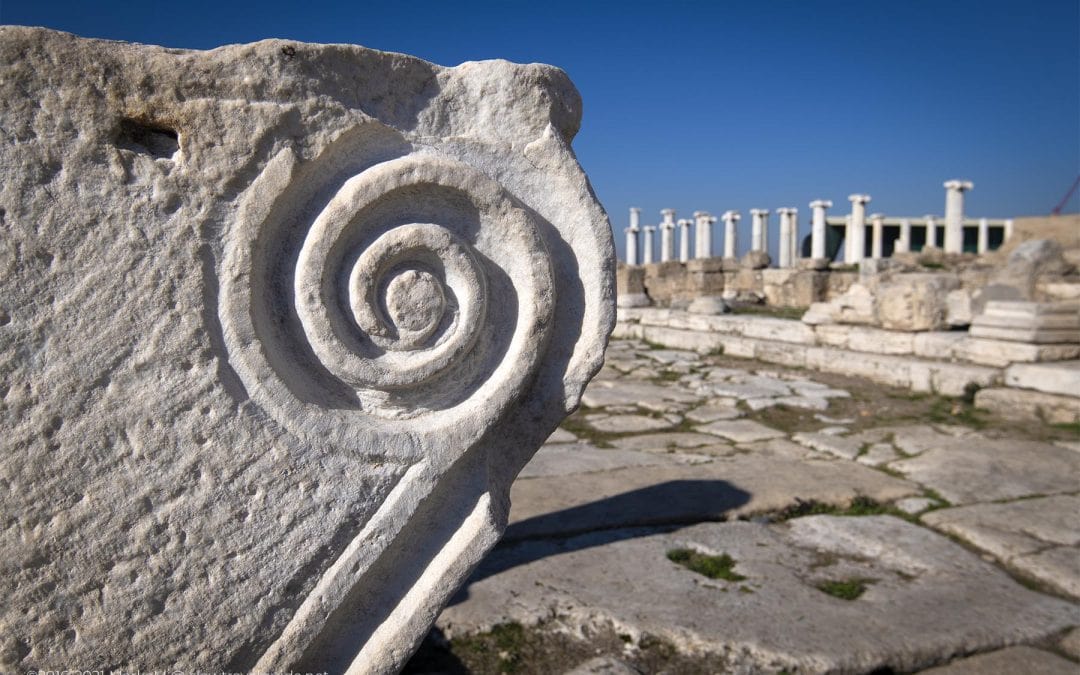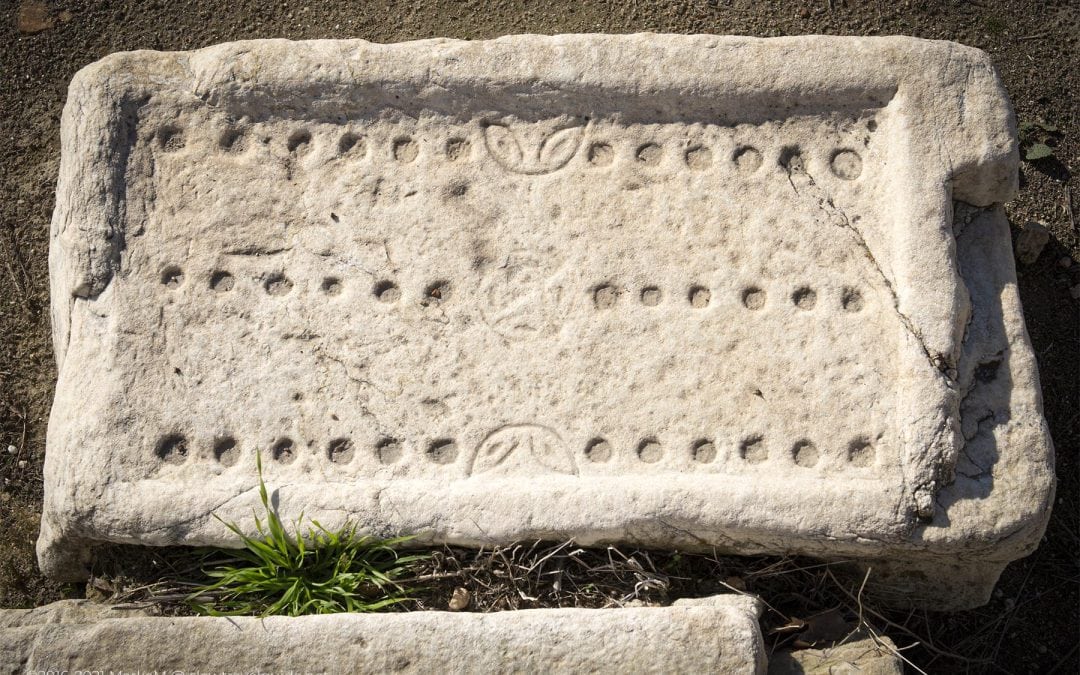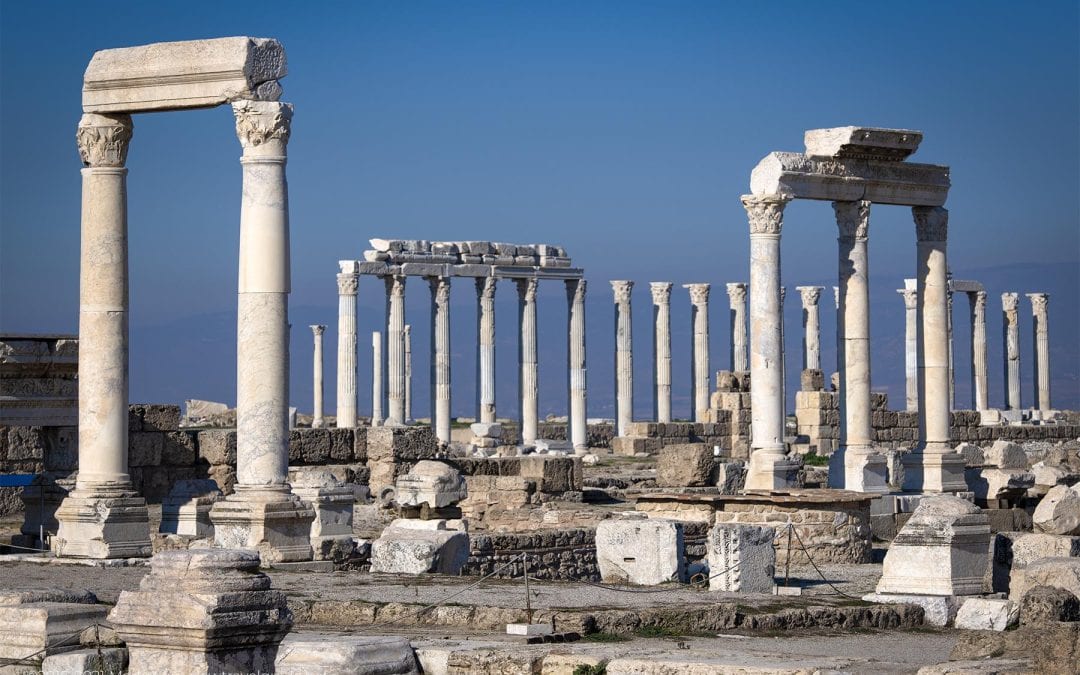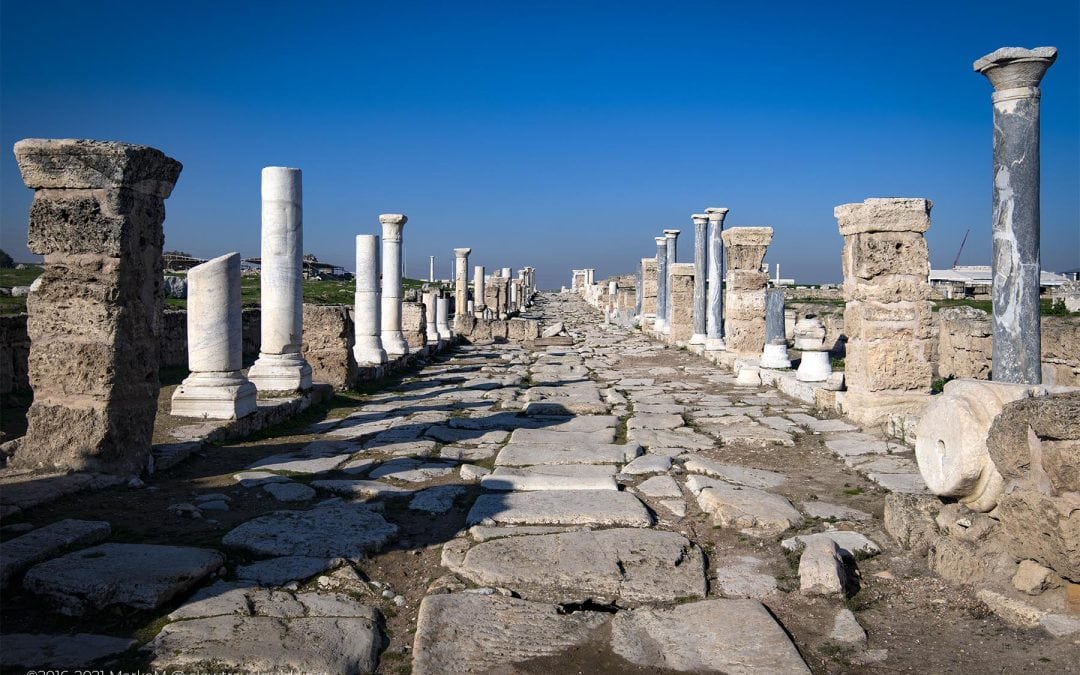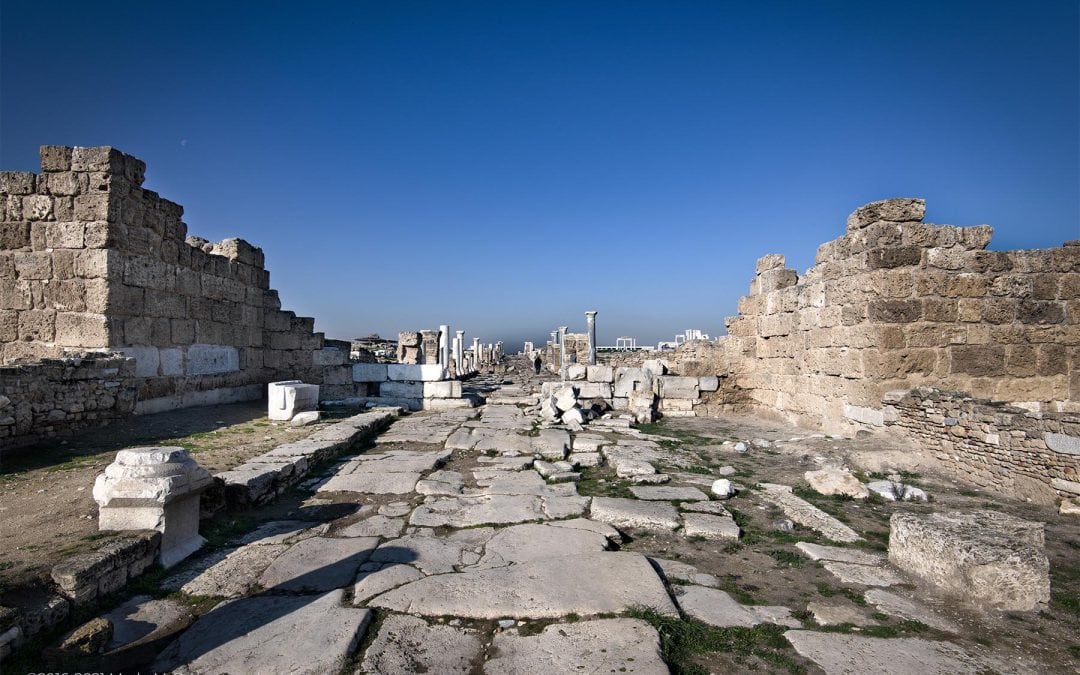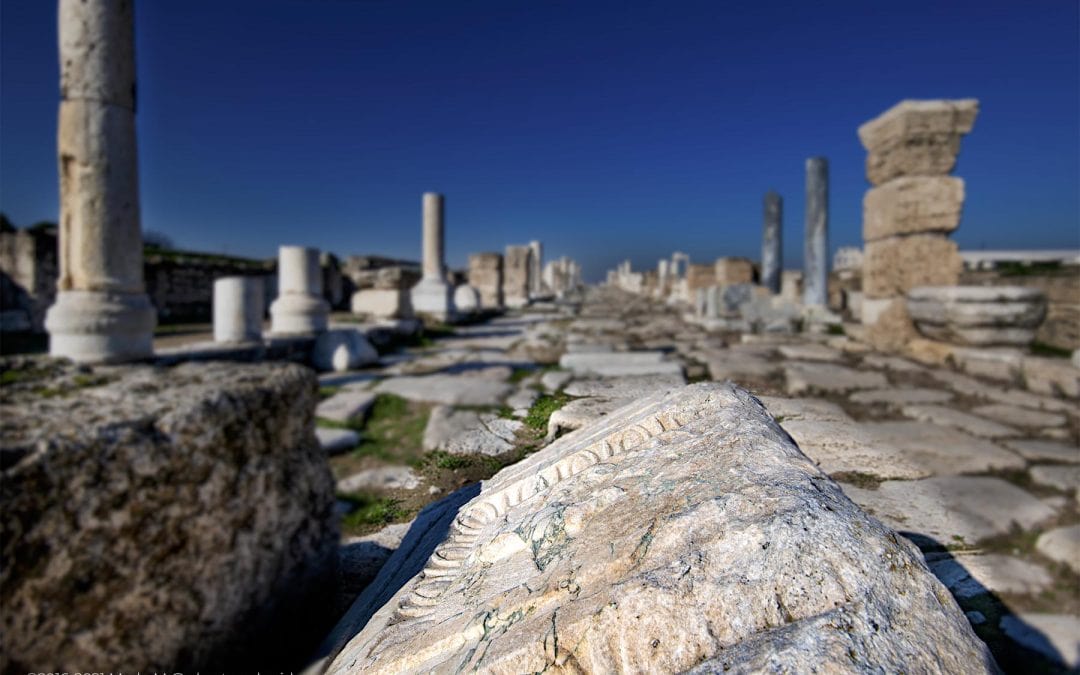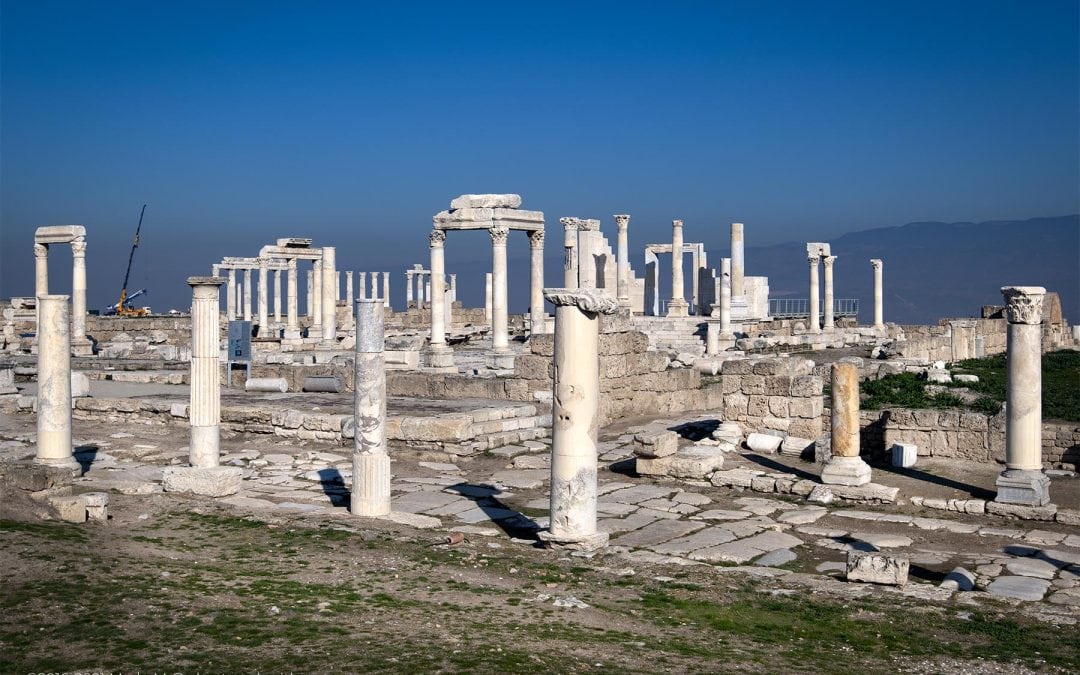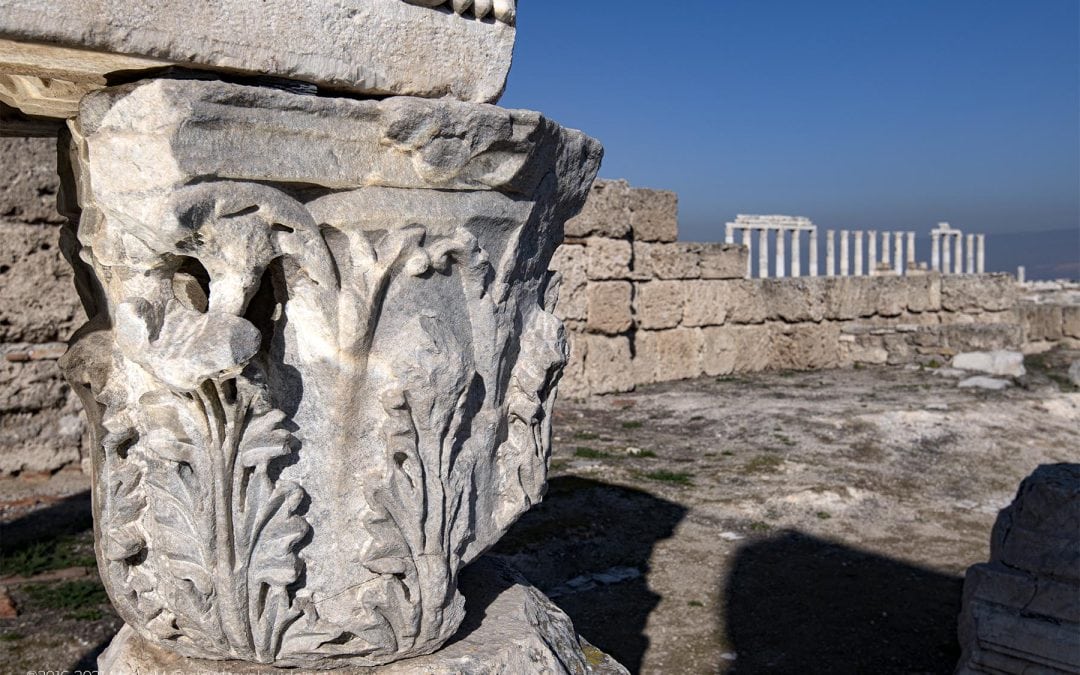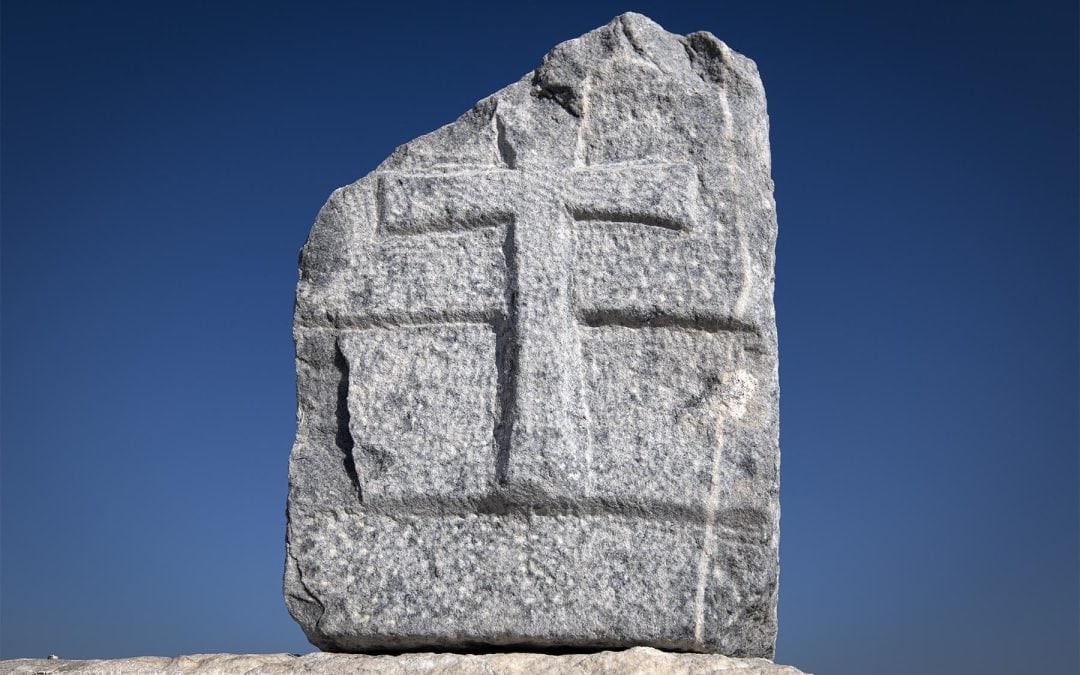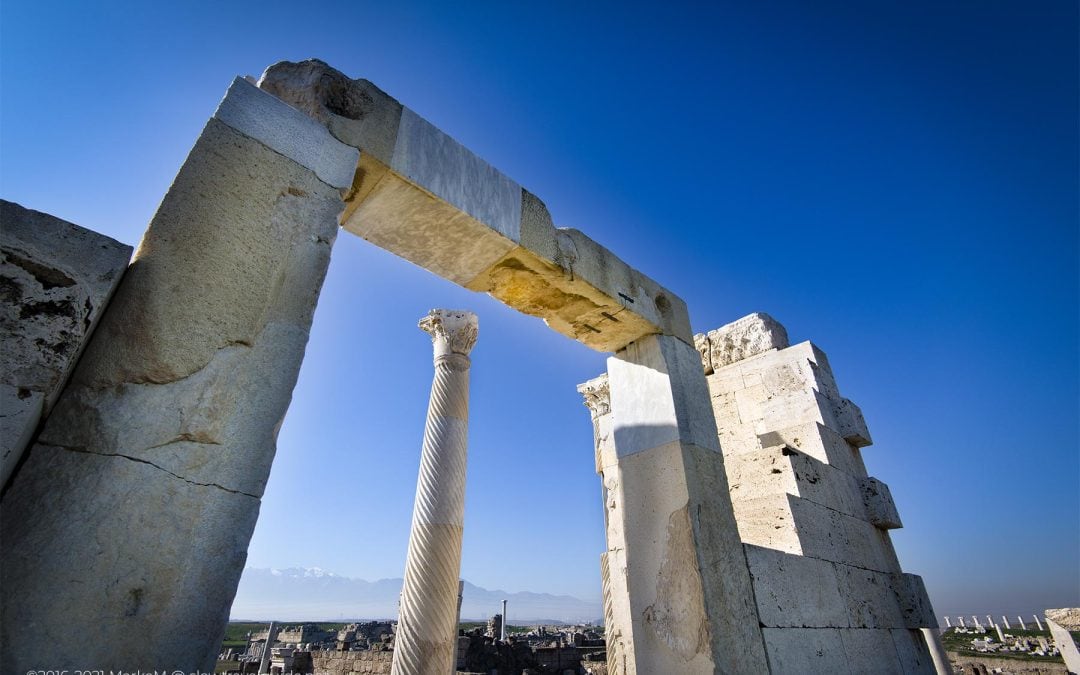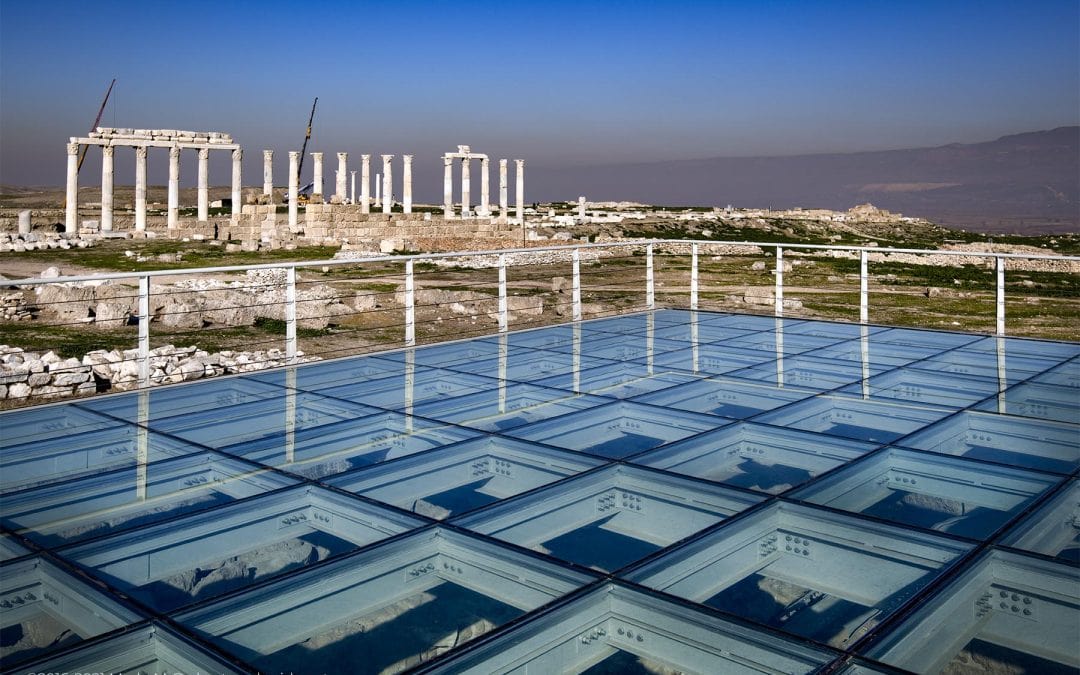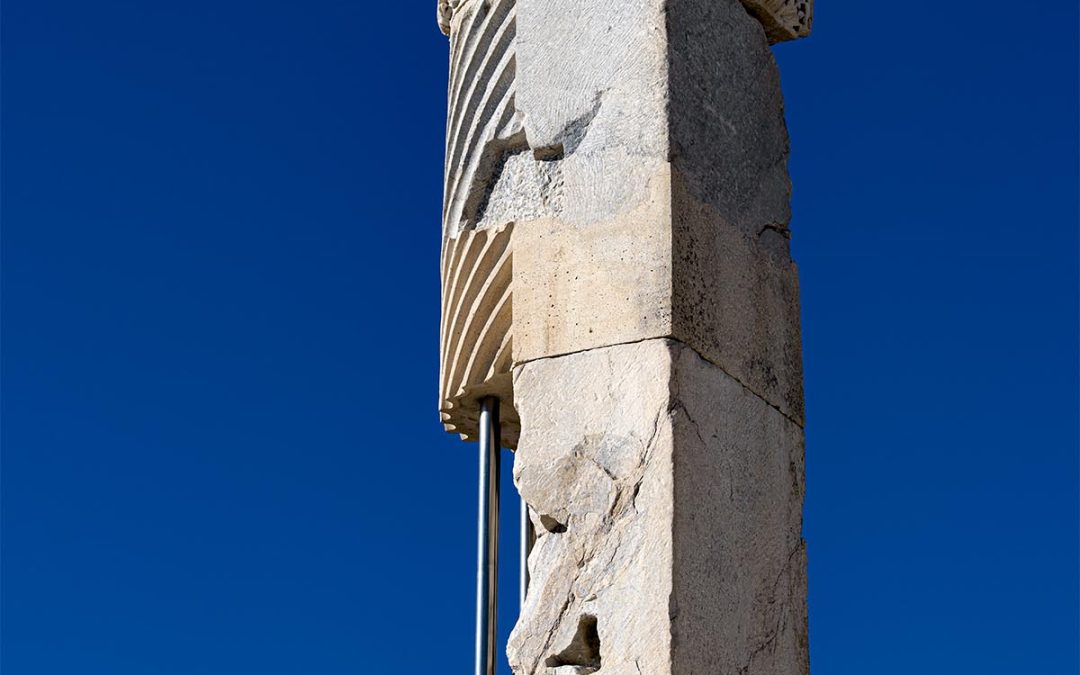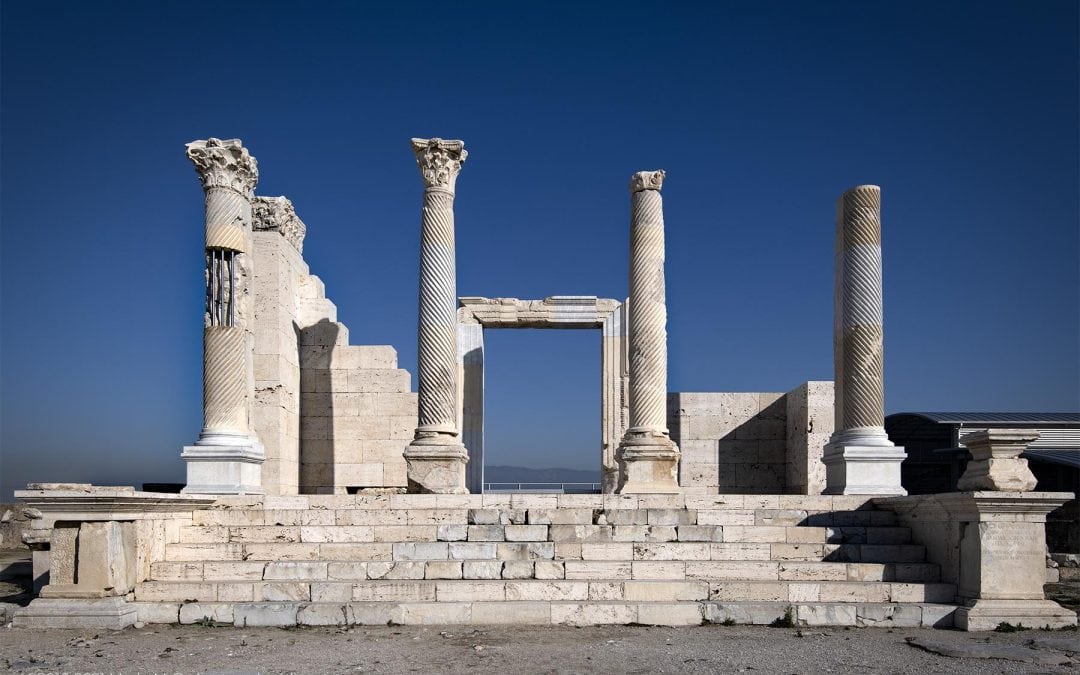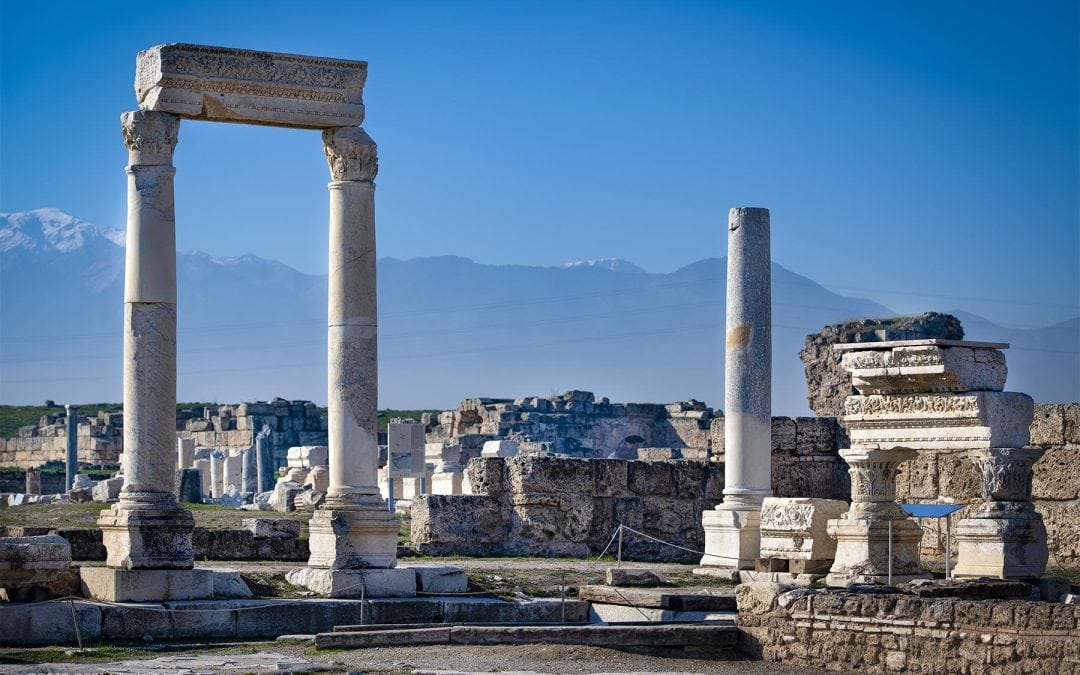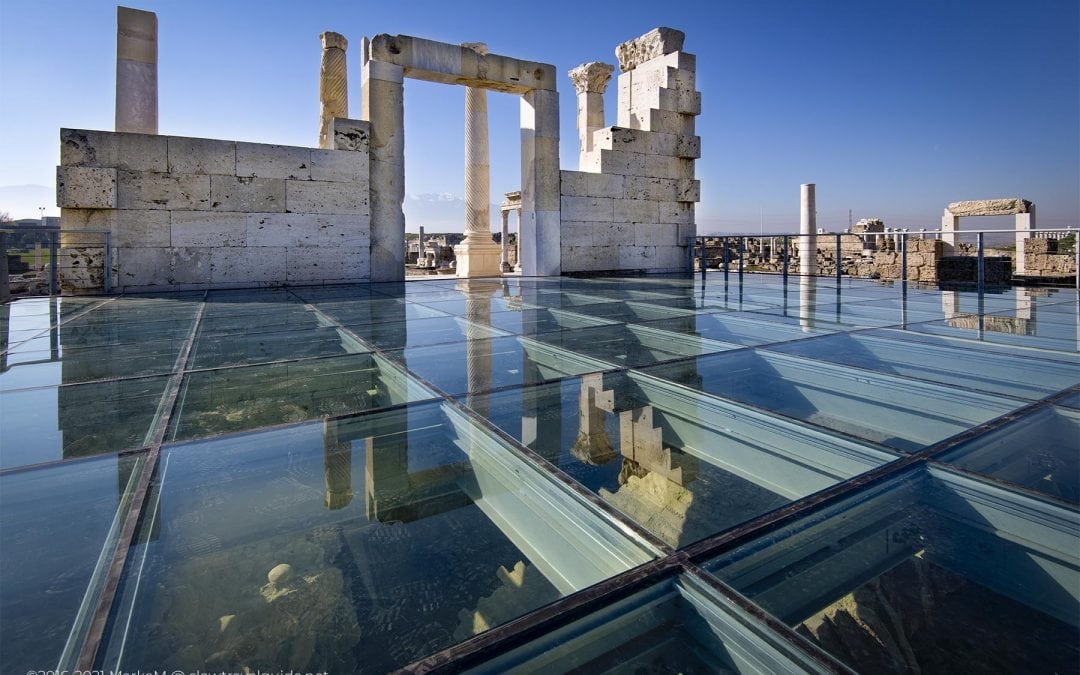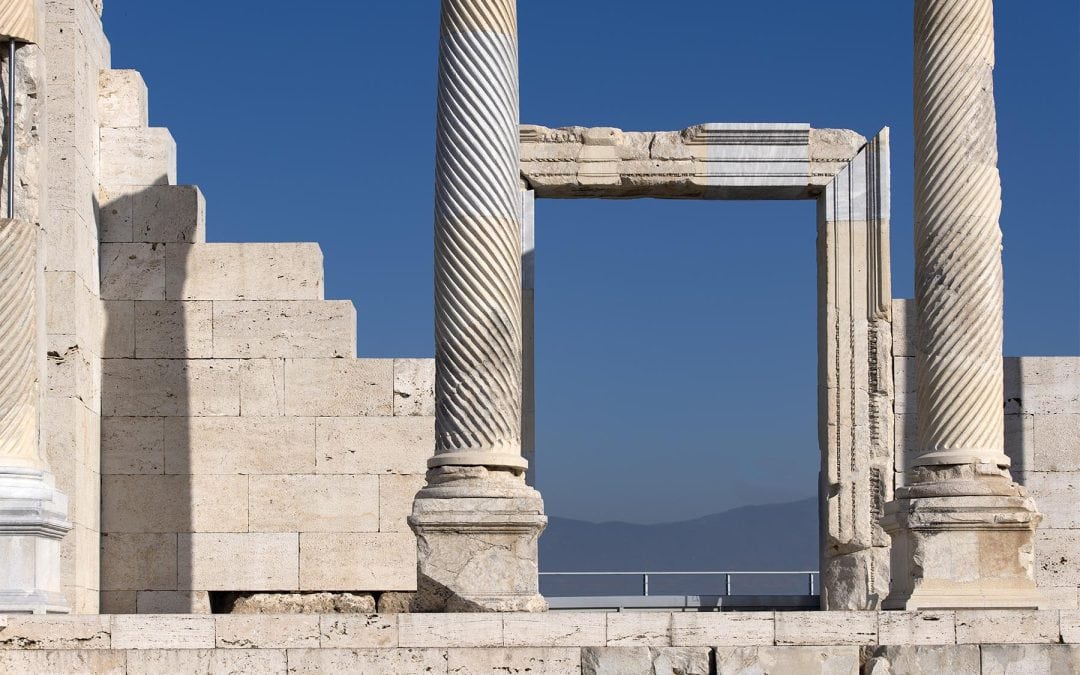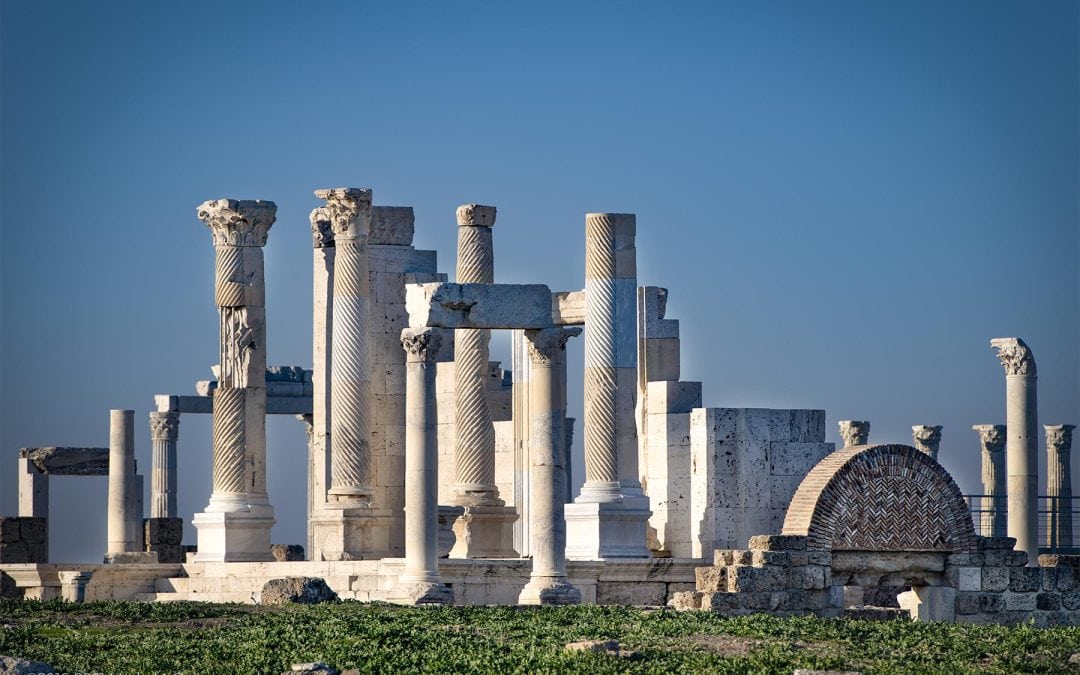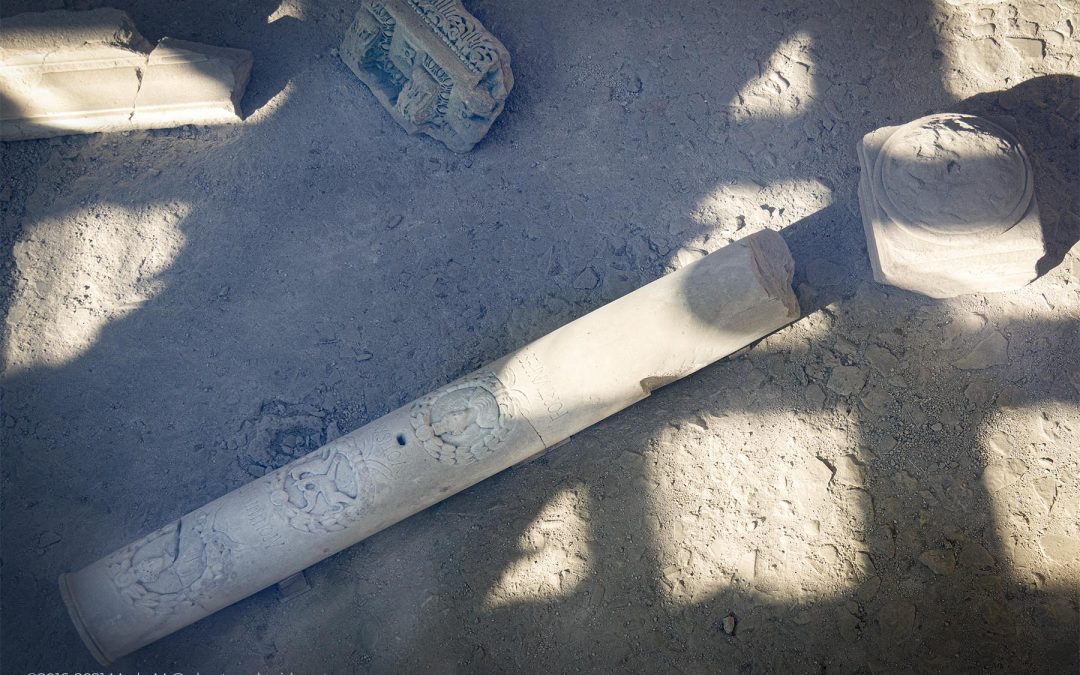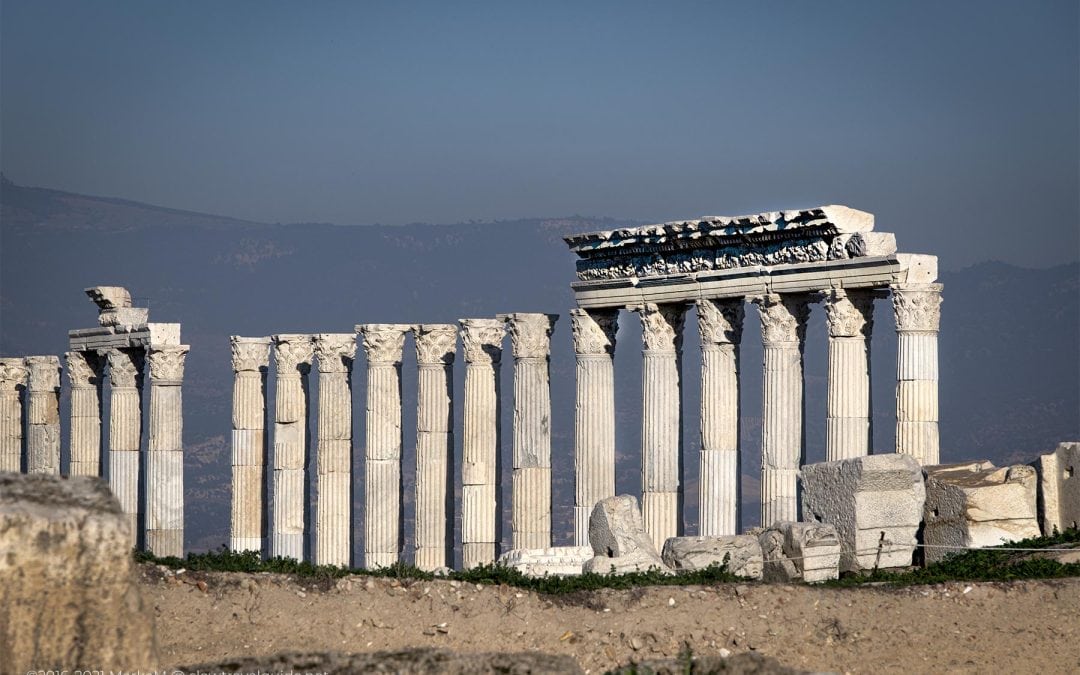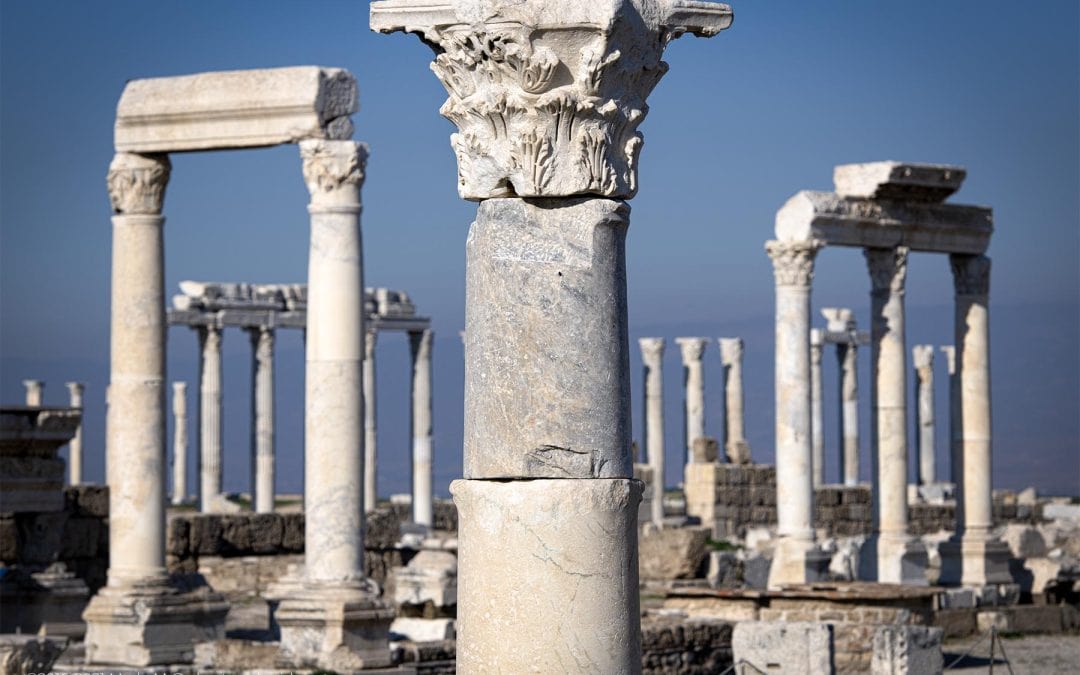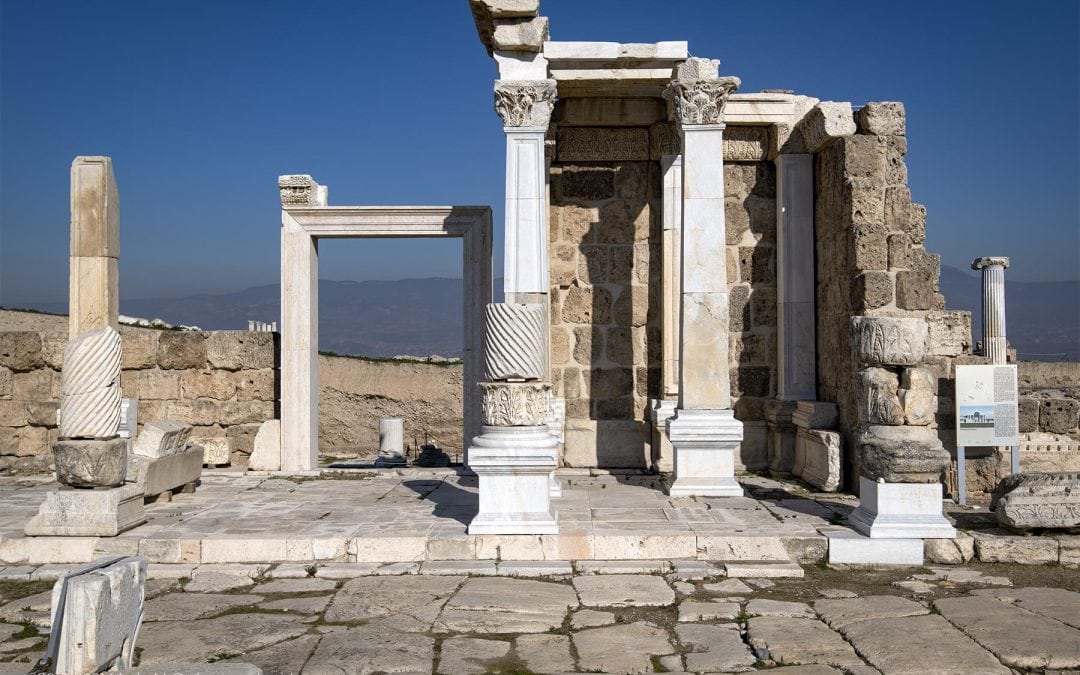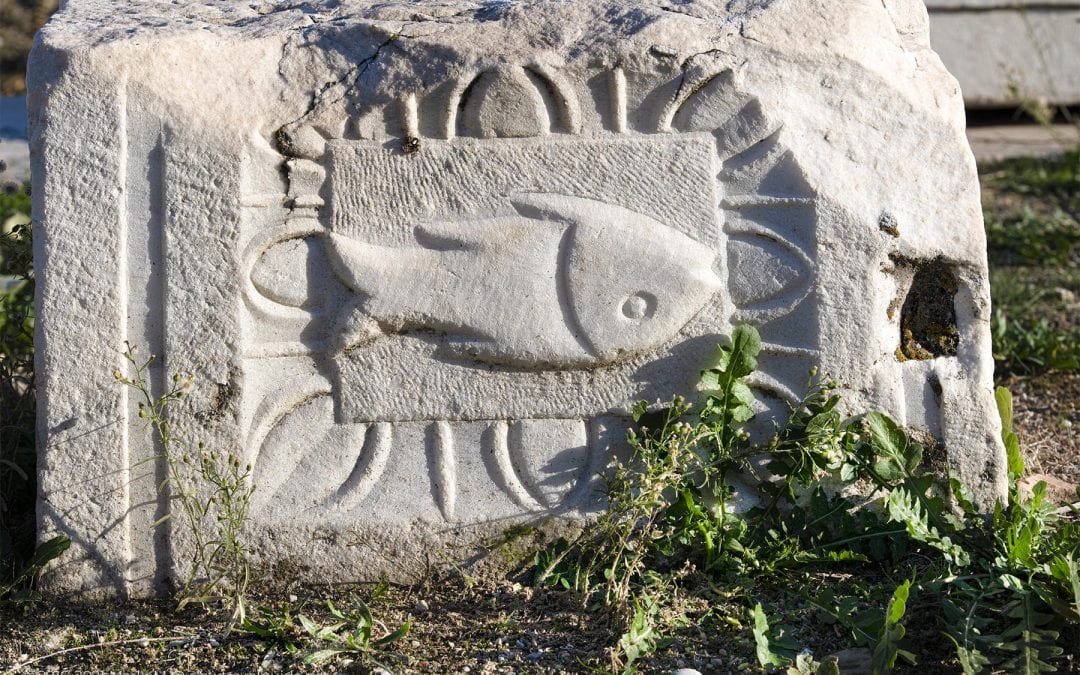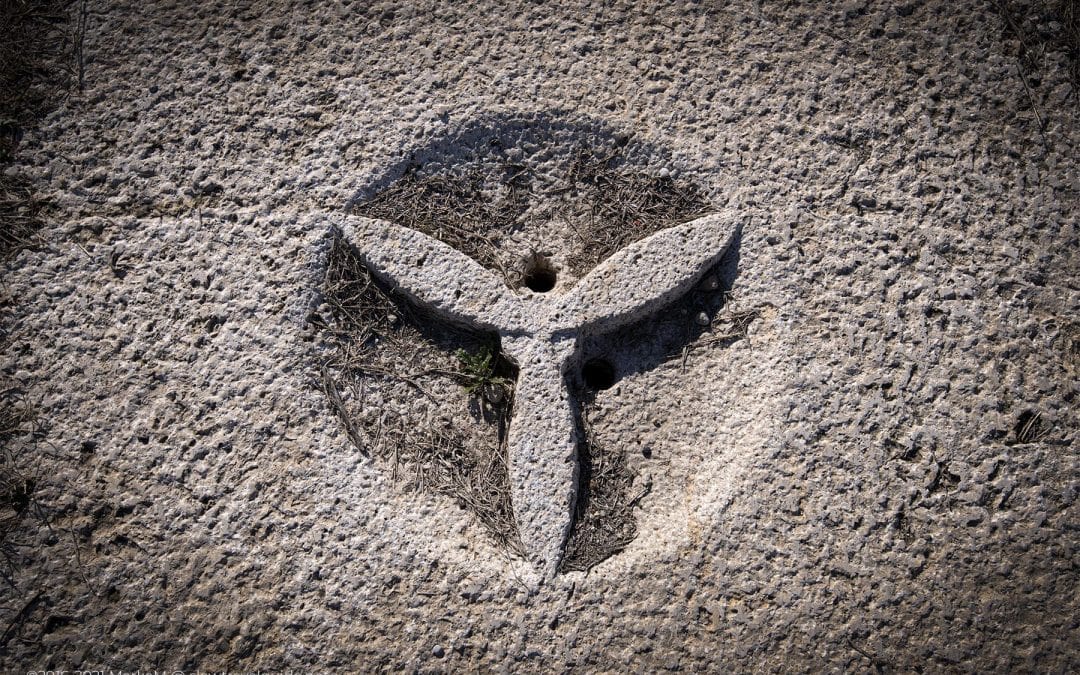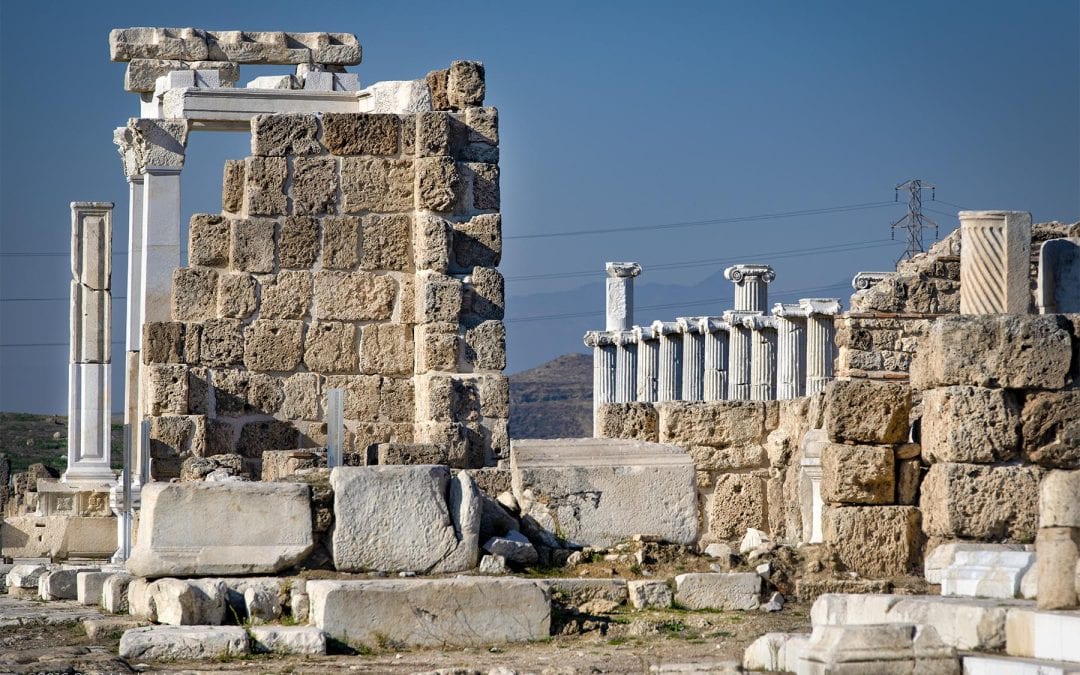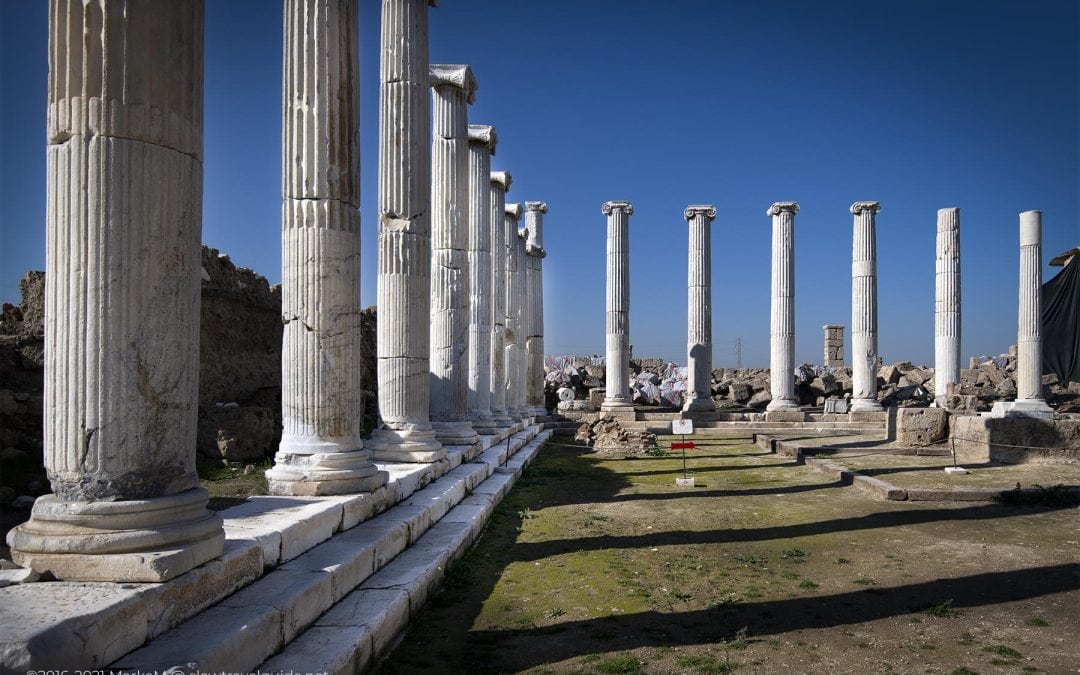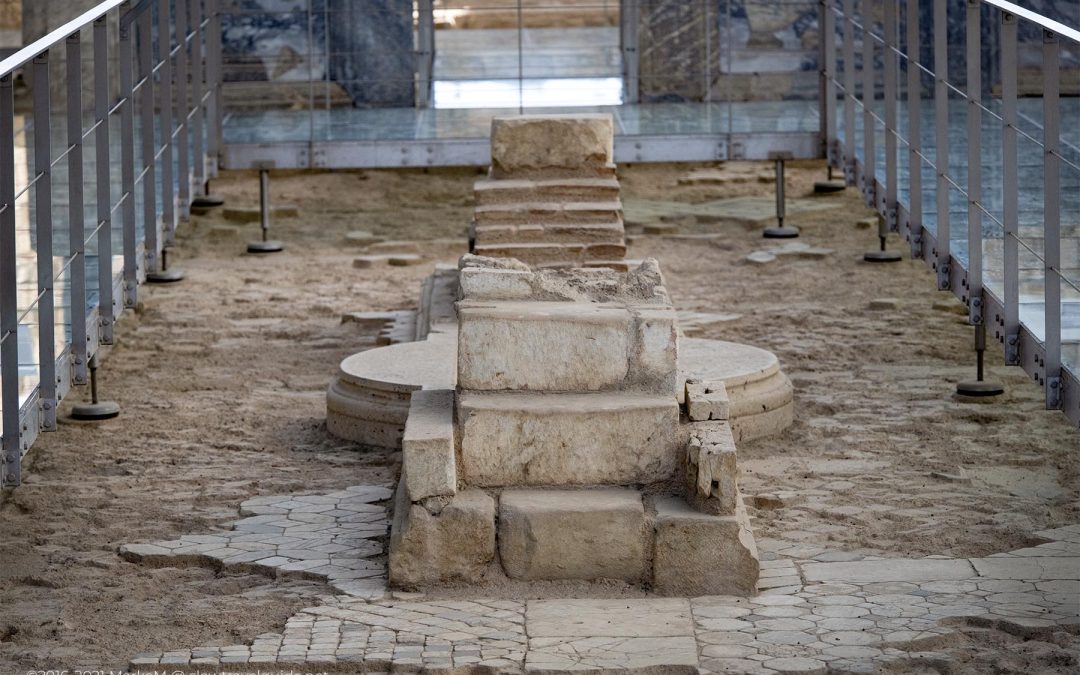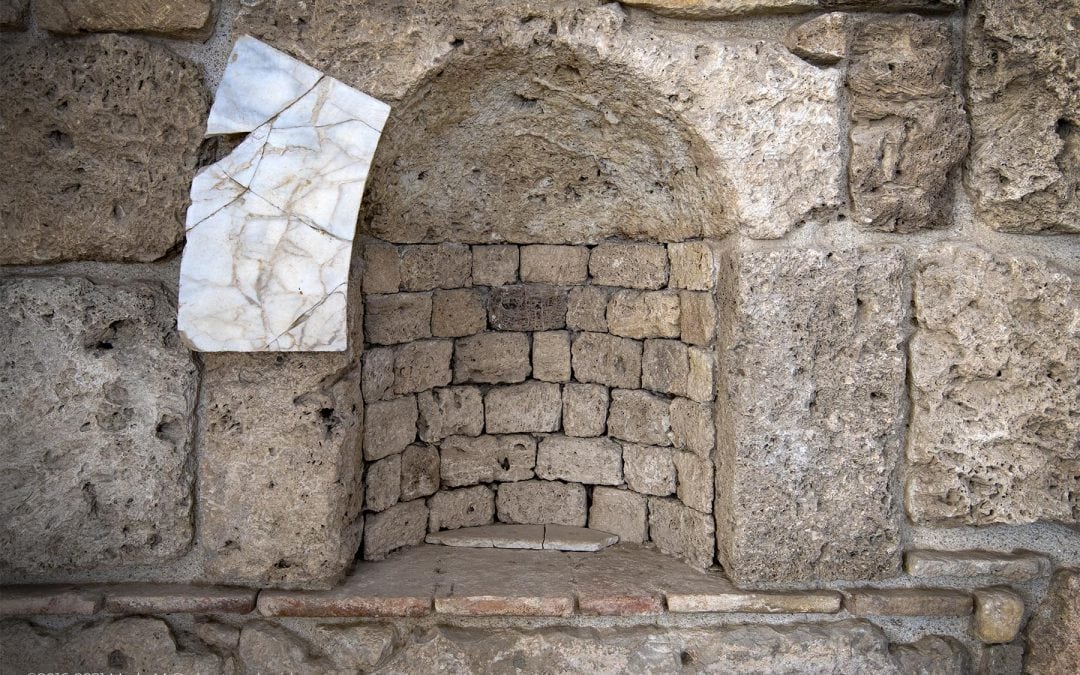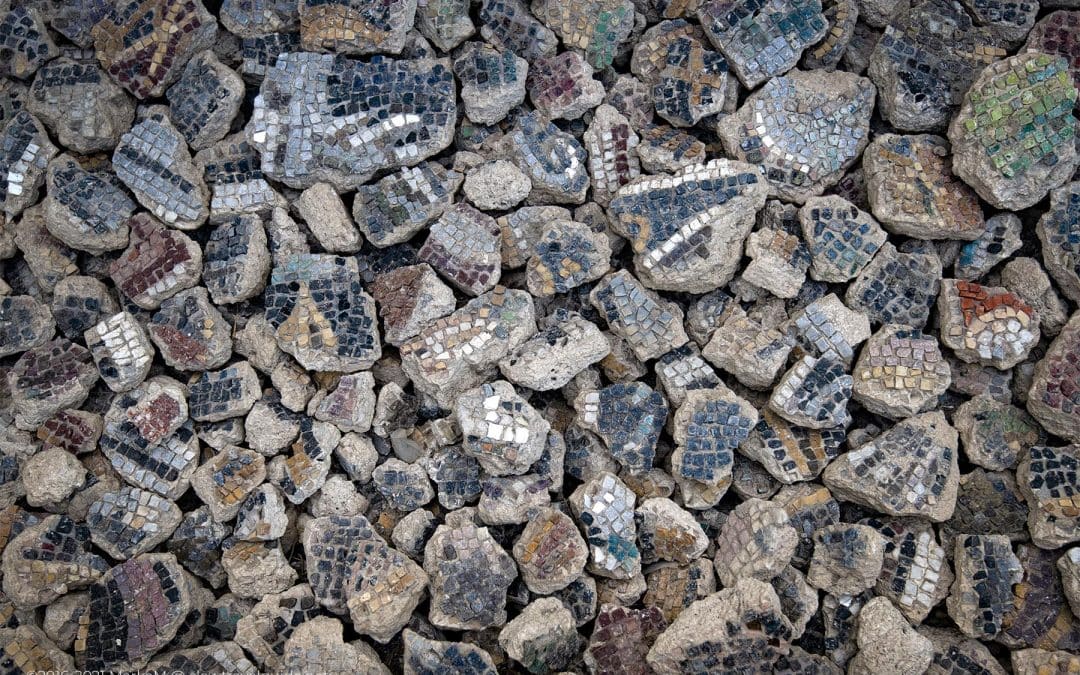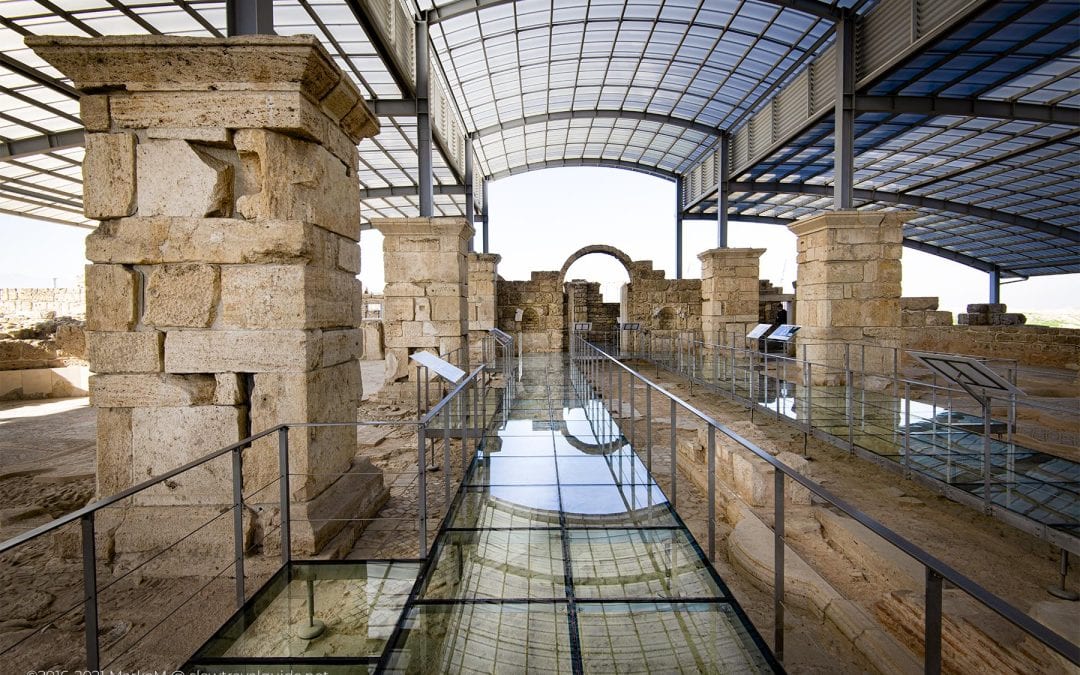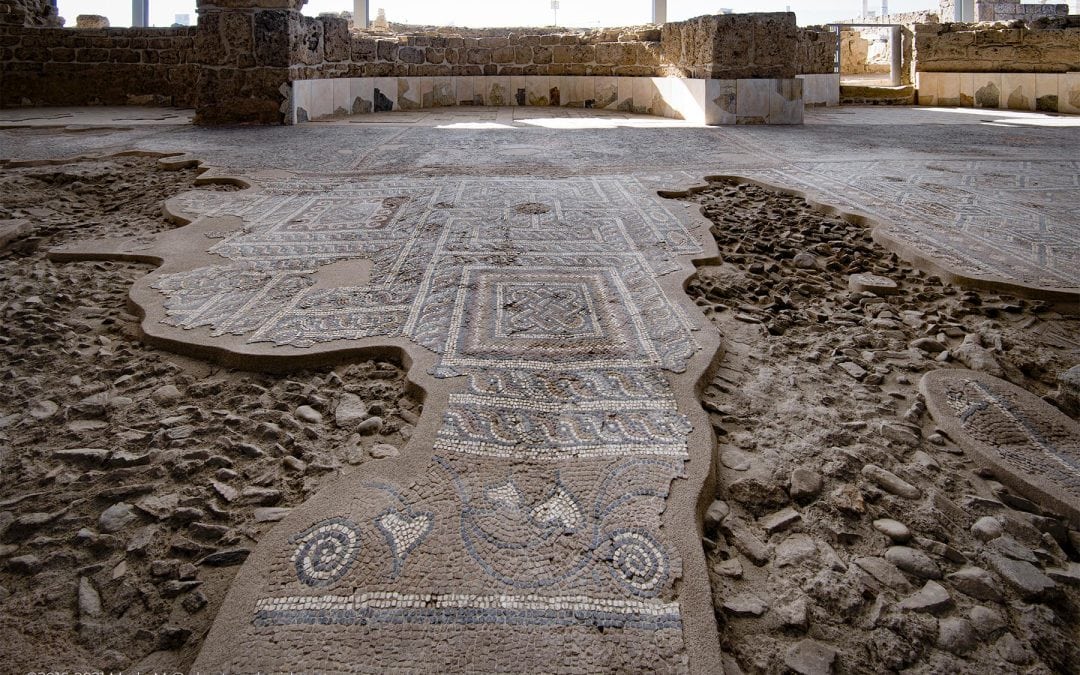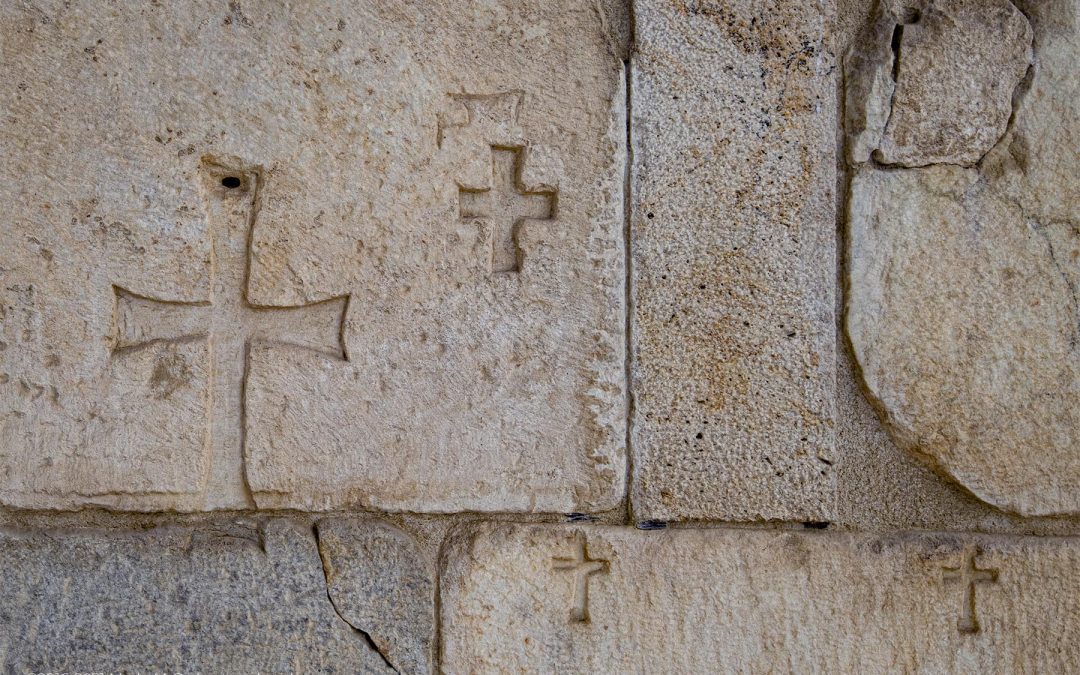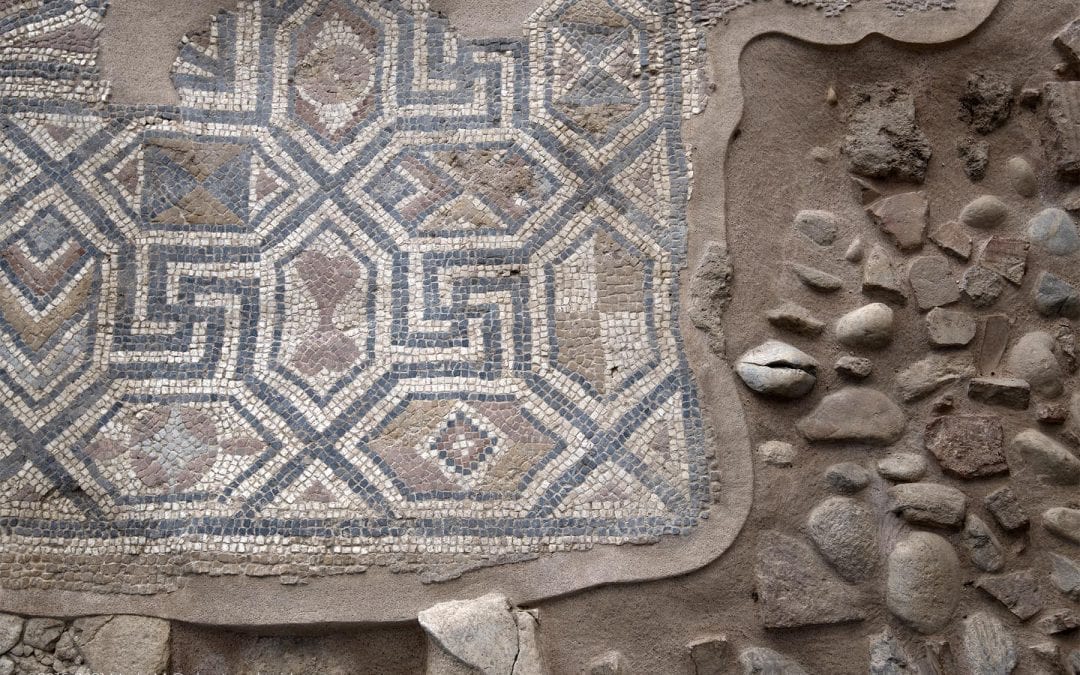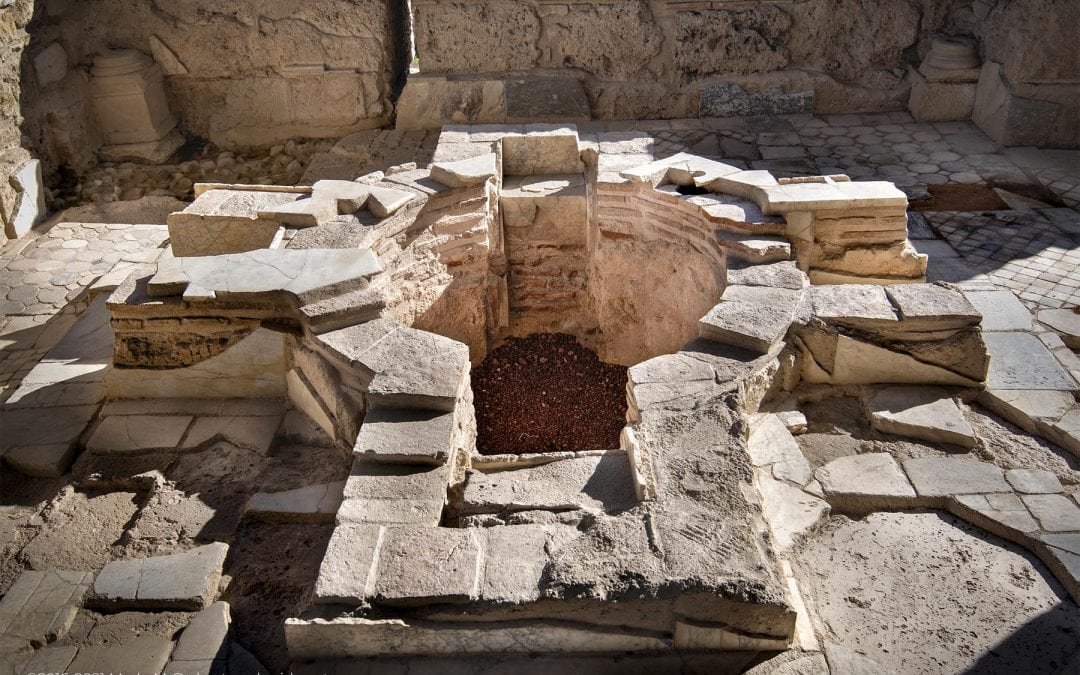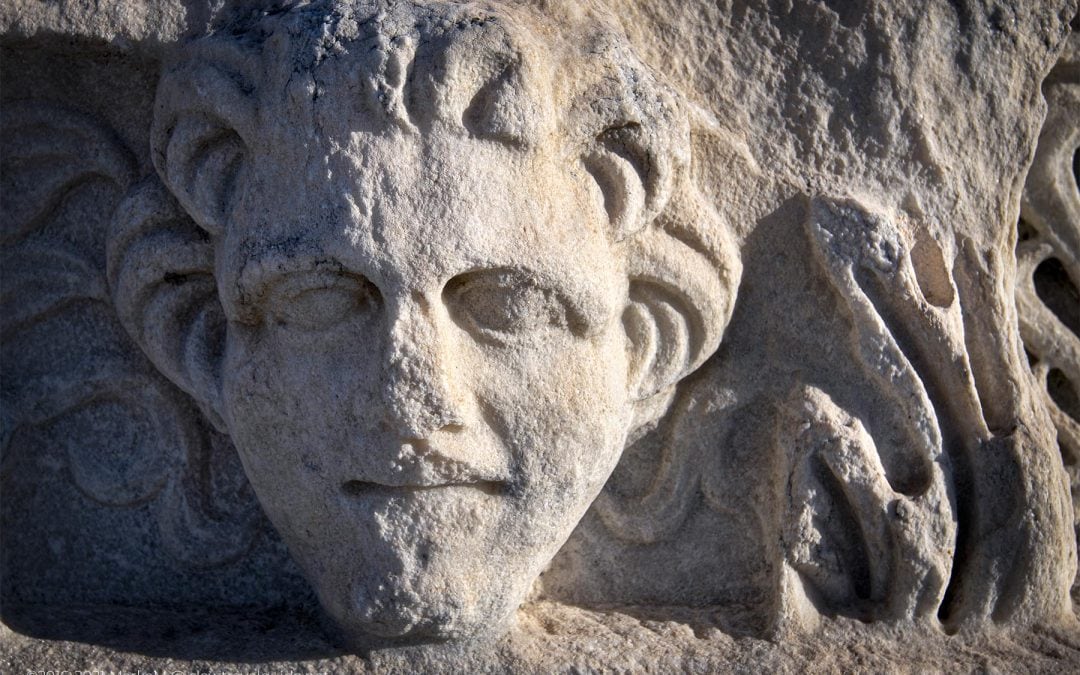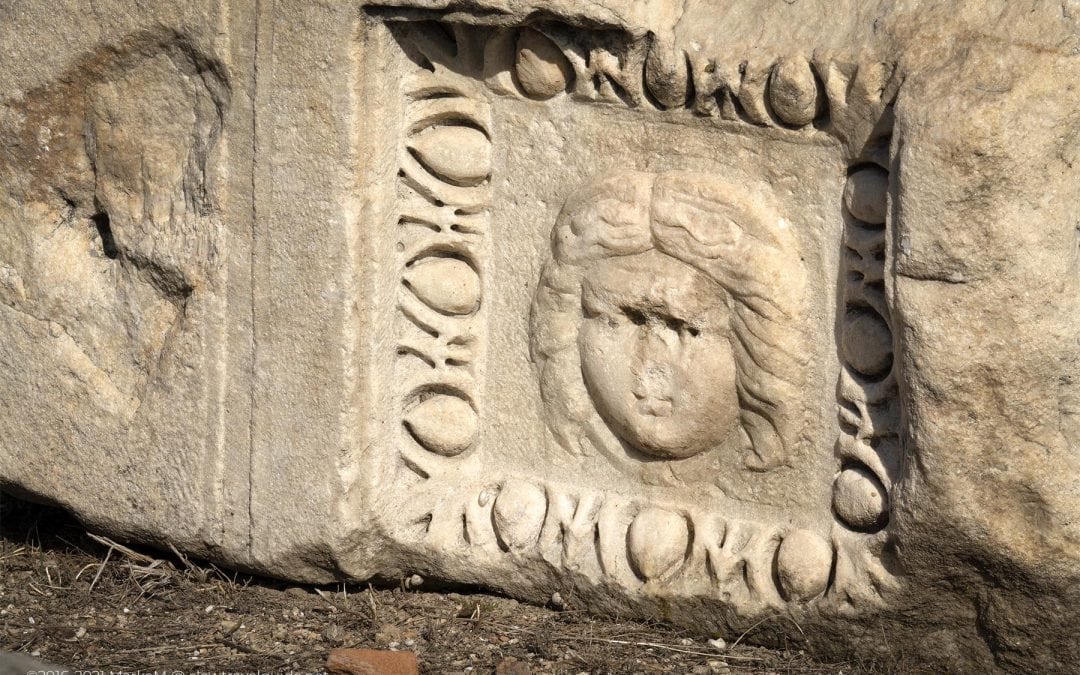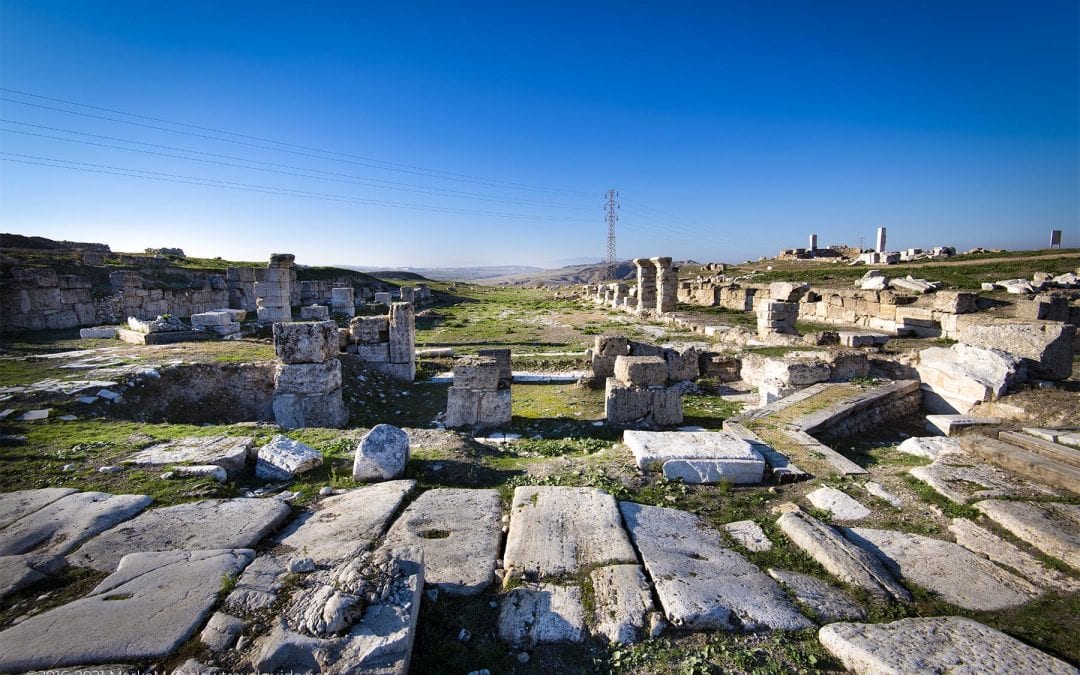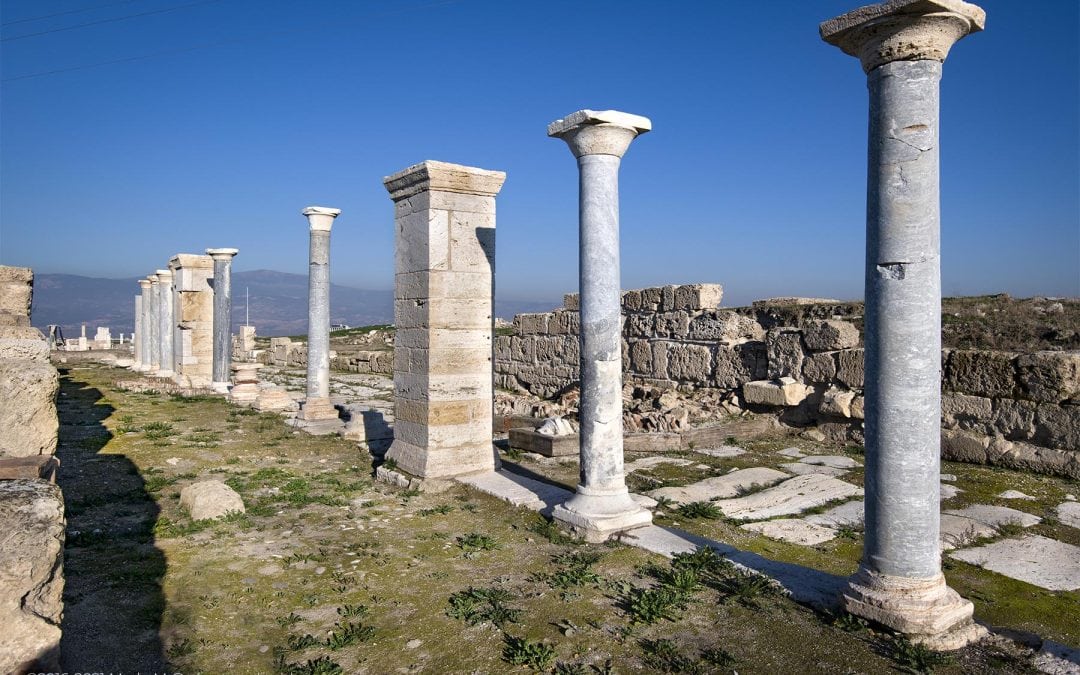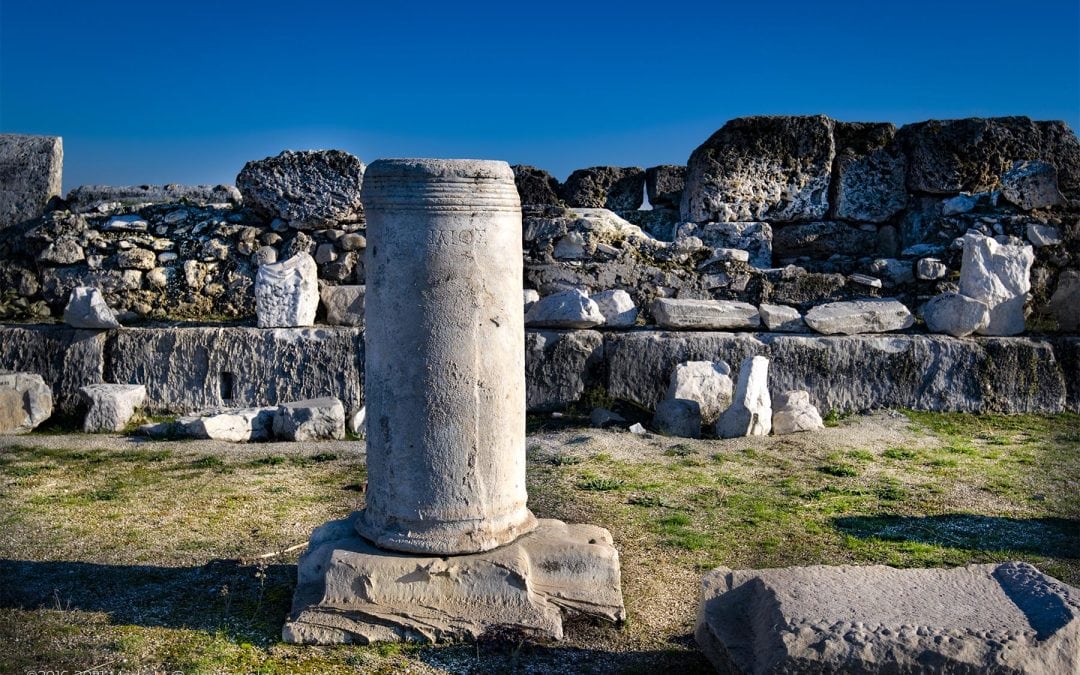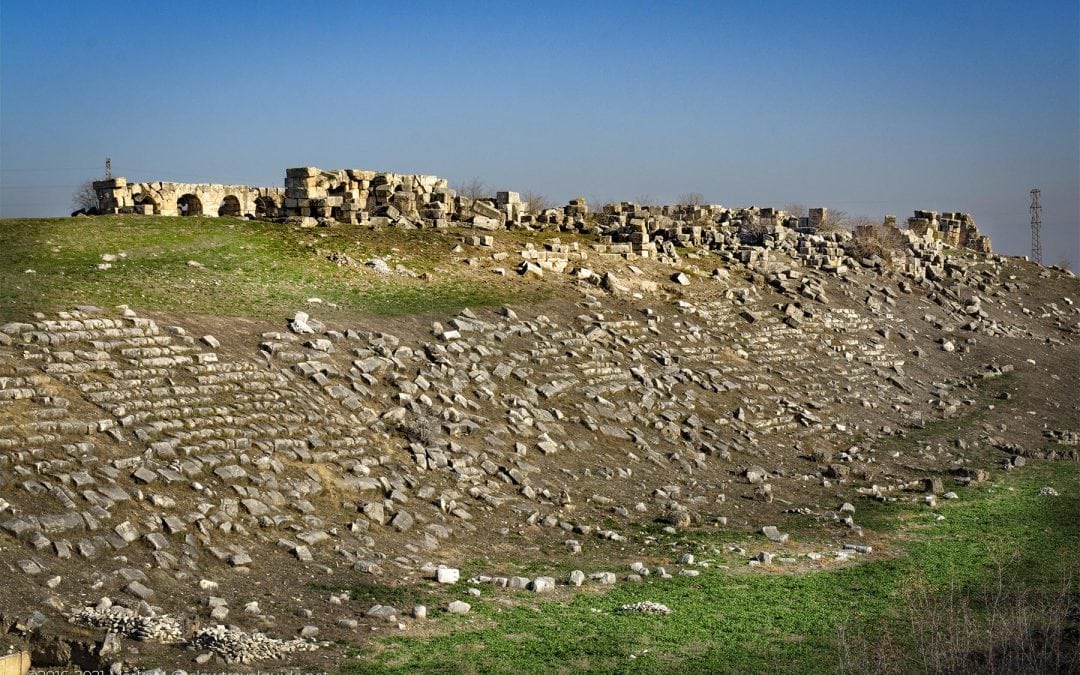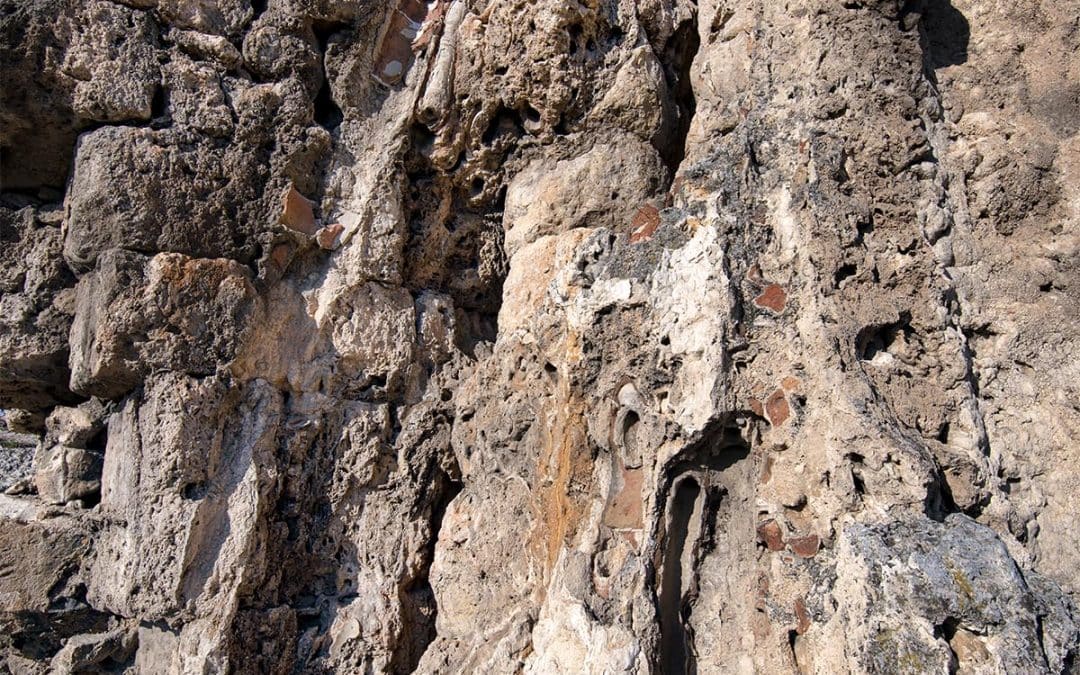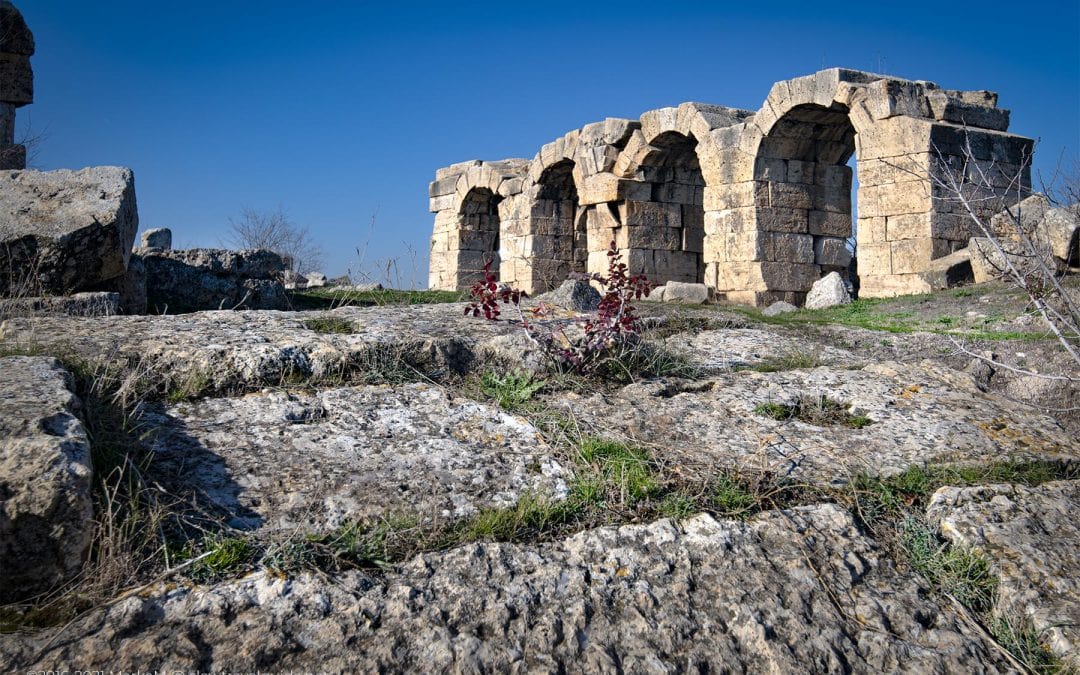Laodicea
Last Church Of Revelation In Anatolia
with Slowtravelguide
Laodicea is an impressive site with many exciting features. Besides the fact that it has many columns that have been re-erected, sitting in the many attractive collonaded streets.
Laodicea (or Laodikeia) sits on a vast terrain, so expect to do some walking to see it all.
We have seen ancient sites which appear more appealing when visiting, but Laodicea compensates this highly with its scale and importance in history. In the least, because of having one of the churches of Revelation on its site on its terrain. Laodicea is an ongoing restoration project on a grand scale. Definitively worth visiting.
As Said earlier, the site is popular with visitors interested in Biblical tours in Turkey because the Last church of revelation has also been restored.
Prof. Celal Şimşek is the leading archaeologist whose goal always has been to create a living archaeological museum site. It gives an authentic feeling when walking around the ancient site.
The Entrance Of Temple A
The History Of Laodicea On Lycus
Laodicea is situated not far from Denizli. Its history goes back as far as the Bronze Age (5500 BC). Findings prove settlements existed in the early Bronze Age and later in the Classical period.
Later in the Hellenistic period, the city was named after Laodike, the wife of Seleucid King Antiochus II.
Earlier the name was Rhoas and before that, Diospolis (City of Zeus). Laodicea was in its days twice as big as Hierapolis.
Laodicea was a prosperous city, a centre of commerce, culture, art and sports,
Textile trade was the primary source of income; marble, grain, and livestock were essential to its economy. However, this is also the location of the Laodicean church. The Laodicean church is the seventh church in the book of Revelation.
Laodicea is located in an area with a lot of earthquake activity.
It has known several earthquakes over time. One earthquake in 494 AD destroyed the town. Laodicea only partly recovered from that. The city was abandoned by its population after the earthquake that happened during the reign of Focas (602 to 610 AD), which damaged the water supply coming from the Başpınar spring.
Explore Laodicea
Laodicea was a big city, so if you plan to see the entire site, you need to walk a bit; the whole site occupies almost 5 square kilometres. Most of the landmarks are concentrated around the church.
In the southern Bath Complex and the stadium, you will have to make a longer walk, but the terrain is easy for visitors. No difficult climbs.
To help you prepare for your visit, we have added a map of Laodicea provided by Tutku Tours.
Laodicea has one of the largest stadiums in Anatolia; there are two theatres, four baths, five agoras, fountains, a bouleuterion, several temples and colonnade streets. Not everything has been rebuilt, but those rebuilt landmarks are awe-inspiring.
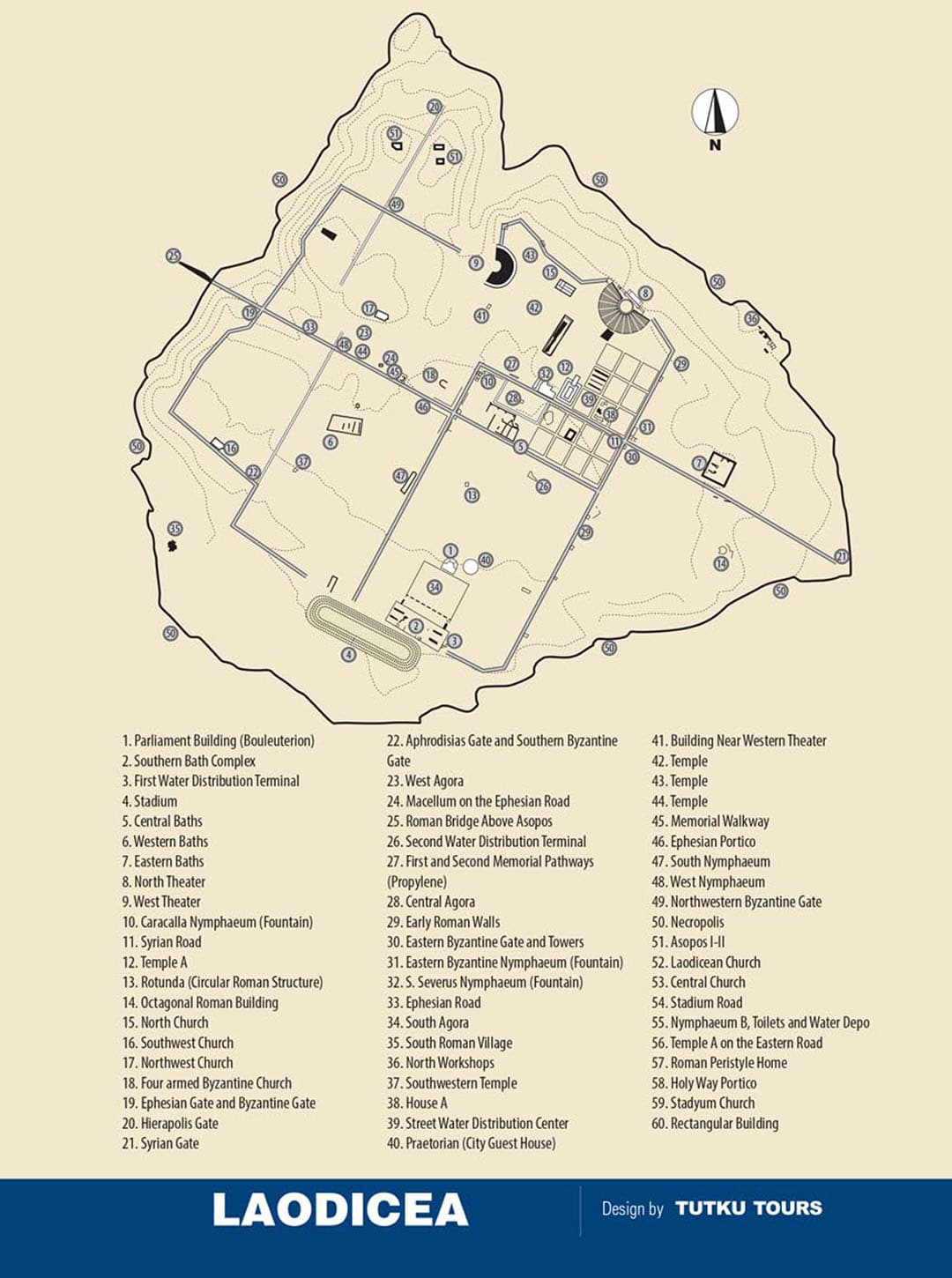
Detail Of The Pavement Of The Syrian Road
Syrian Road
You enter Laodicea at the East Byzantine Gate and Tower.
This connects to the Syrian Road, a collonaded street with various Porticoes and shops.
The street goes back to the Roman Empire. The street itself measures 900m, 400m is already excavated.
A beautiful sight.
The Syrian Road takes you past houses, Temple A, some fountains, and the Central Agora.
See higher on this page the Duodecim Scripta tablet, an Avant la Lettre game board. The predecessor of Backgammon?
It is a beautiful walk starting from the Byzantine Gate and towers built in 395 AD. It completed the defence wall around the city. Original materials were used for the restoration.
Temple A
This temple collapsed partially with the 494 AD earthquake and remained in use until it was utterly was destroyed during the earthquake in the 7th Century.
The temple had 54 columns in its glory days.
The temple was dedicated to Apollo, Artemis, and Aphrodite.
Later it became a church archive.
An extensive restoration took place, 19 columns were re-erected.
Also, the stairway and the doorway were rebuilt.
A large glass terrace is open to the public and gives a view of the interior below.
Temple A, Column Parts Lying Around The Site Waiting To Be Re-erected
Temple A
The Corner Columns Give Away A Tip Of How Impressive The Temple Once Was.
The Central Agora
The Central Agora sits on the south side of the Syrian Road.
Also, the Central Baths can be found in that area.
Built during the Roman Empire was in use until the Byzantine period. Porches and shops surrounded the Agora. The column that sat in the middle is re-erected and a lonely spectator of the remains of its Agora. It symbolized the uniqueness of God and the power of Christianity.
This must have been stunning in its time, but now not much is left of this grand Agora.
On the other side of the street sits the Septimius Severus Nymphaeum. This fountain was excavated in 2003.
The pool measured 41m by almost 15m.
A Beautiful Play Of Light At The North Agora
North Or Sacred Agora
On the opposite side of the Septimius Severus Nymphaeum, two Propylons lead to the north or Sacred Agora.
The Central Propylon has a double-wing doorway with a console above it and three postaments on both sides.
Four steps will take you from the Propylon to the North Agora. This place used to be Temenos or the Holy Court during the Roman Empire. It became an Agora in the 4th century.
Laodicea’s North Agora
The North Agora is huge, covering an area of 265 x 128 meters, with a porch leading to the theatre in the wall of the porch.
North Agora was turned into ruins like many others after a destructive earthquake. Many columns were re-erected during the restoration work, and you can see how deep you have to dig to reach the original floor of the Agora.
You can see Pamukkale In The Background.
This is a letter from the apostle John to the Laodicean church. It is on display in the church:
“To the angel of the church in Laodicea write: These are the words of the Amen, the faithful and true witness, the ruler of God’s creation. I know your deeds, that you are neither cold nor hot. I wish that you were either one or the other! So, because you are lukewarm – neither hot nor cold – I am about to spit you out of my mouth.
You say, ‘I am rich; I have acquired wealth, and do not need a thing.’ But you do not realize that you are wretched, pitiful, poor, blind, and naked. I counsel you to buy from me gold refined in the fire so you can become rich; and white clothes to wear, so you can cover your shameful nakedness; and salve to put on your eyes, so you can see.
Those whom I love I rebuke and discipline. So be earnest and repent. Here I am! I stand at the door and knock. If anyone hears my voice and opens the door, I will come in and eat with that person, and they with me. To the one who is victorious, I will give the right to sit with me on my throne, just as I was victorious and sat down with my Father on his throne. Whoever has ears, let them hear what the Spirit says to the churches.” (Revelation 3:14-22)
The letter refers to the city’s notorious wealth. And, of all the letters sent to the Seven Churches in Asia, this is the only one without a single word of thanks. Next to the letter of the Apostle John is an overview of the canons established by the Laodikeia Council to clarify questions about interpretation, ceremonies, and canon law. Quite inspiring reading material!
Laodicean Church Interior Seen From The Bema
Church Of Laodicea
Laodicea Church was built in 313 AD during Constantine The Great was in power.
We know the church is the most famous church of the seven revelations.
Laodicea Church was not recognised until 2010, after which it was fully excavated the same year.
The chapel has a layout with 11 apse-like niches.
The naos is a three-aisle basilica, with north and south aisles paved with mosaics.
The baptistry was laid in opus sectile.
West Theatre
There are two theatres in Laodicea on the Lycus. The first to be built was the West Theatre.
The theatre was built on a natural slope, facing the early settlements of the city. It has a capacity of 8,000 people. It was in use from the Hellenistic period to the great earthquake during the reign of Focas.
North Theatre
The North Theatre was built in the 2nd century AD to cope with the city’s increasing population, and it made the West Theatre unable to meet the demand for theatre seats.
The North Theatre, which can accommodate 12,000 people, faces Hierapolis, and the white travertines of Pamukkale can be seen from the observation deck. This theatre was used until the 7th century and has not been restored.
From the 7th century until the nineties, it was used as a quarry, and lime kiln, just like was the West Theatre.
Part Of The Stadium Road
The Stadium Road
The Stadium Road leads to the city stadium. It will take you past the latrines, the porch of Ephesus Street, more Nymphaea, several public buildings, and the central baths. This street was built from 84 to 85 AD when Domitian was in power.
The side porch differs two levels from the street, and the street itself is paved with big travertine blocks.
From the 2nd century AD to the first half of the 7th century AD, Stadium Road was used.
Detail Of The ‘stock’ Near The Stadium Road
View Of The Gymnasium Complex From The Bouleuterion
Stadium and South Bath and Gymnasium
The stadium is located to the Southwest of the city. Near the South Baths and the Gymnasium Complex.
The stadium can seat 25000 spectators.
It measures 285 x 70m. en is quite impressive. The nearby bathhouse served as a bathing place for the athletes.
Strangely, the South Bath is said to be the best-preserved building in Laodicea. This seems to contradict its appearance, and however, unlike many other landmarks, the stadium complex has not been restored. This arched building was built in 135 AD to commemorate the visit of Emperor Hadrian. It measures 133 x 75 m and is connected to the South Market to the north.
What To Expect
How To Get There: Private or rental car (check the map below).
Nearest Airport: Denizli Çardak Airport.
Parking: Yes.
Terrain: Easy to medium.
Stroller: Yes.
Income: Yes (Museumpass is valid).
Facilities: A small cafe in the car park and a toilet.
Best Time To Visit: All year, depending on the weather.
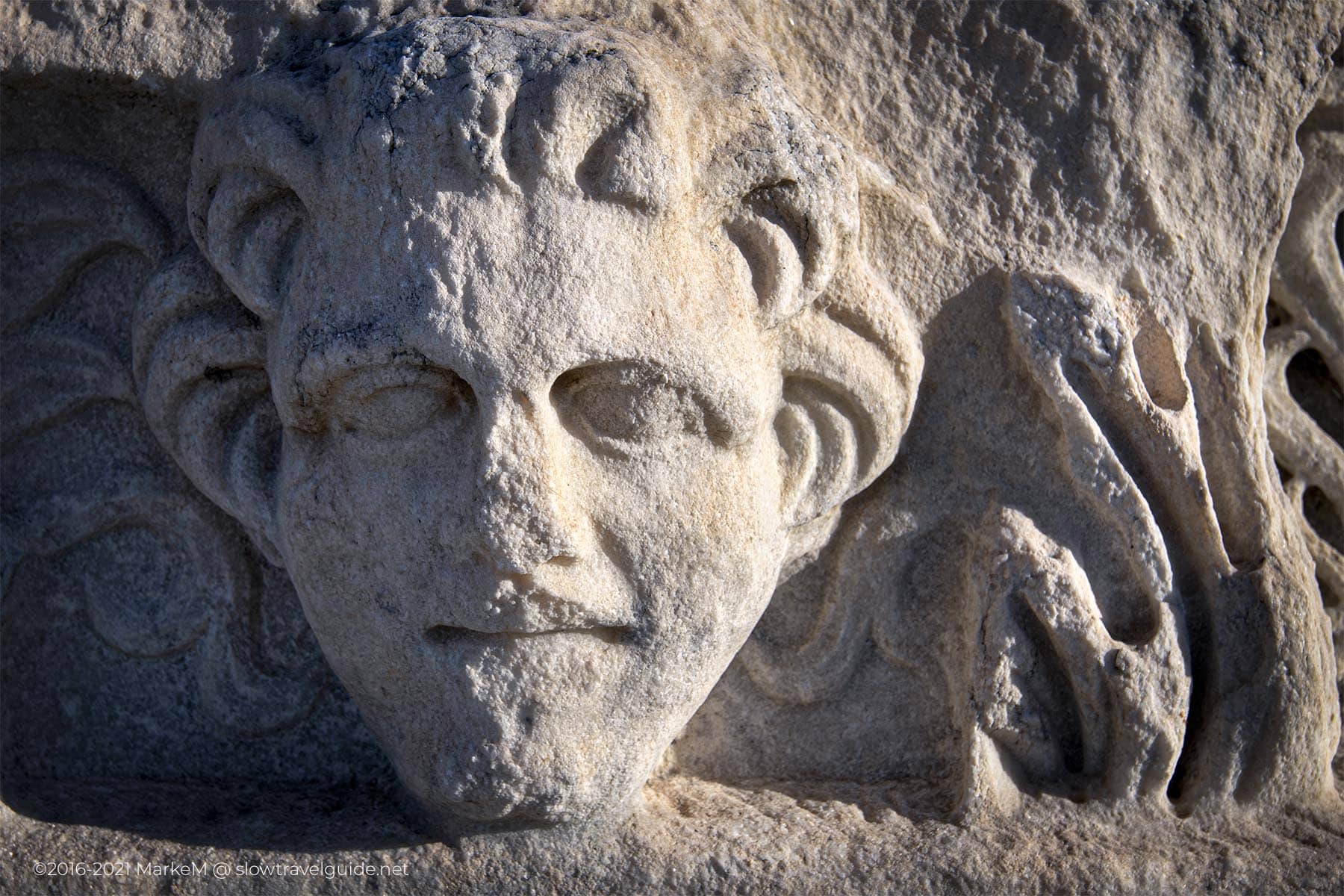
Look At The Size Of That Stadium!
Bits And Pieces Everywhere In Laodicea On The Lycus
Practical Information
In short, Laodicea on Lycus is definitely worth your time, but the pictures speak for themselves. Some sources mention that you only need about half an hour for a short trip, we disagree. If you want to experience the site entirely, count at least an hour (or better still, two hours) to complete the excursion. After all, we spent the whole day here.
There is so much to see and do, especially if you want to see the reconstruction of the ancient city. Laodicea is a work in progress; this means you have to accept that some parts will not be accessible due to restoration or excavation work. You’re walking around a construction site, but imagine you’ve been tasked with rebuilding a piece of history. It’s charming! The good thing is that even if you decide not to pay for the audio guide, you’ll find plenty of information about each landmark on-site.
Be sure to wear sturdy shoes and bring water in hot weather. There are no trees in sight, so it is almost impossible to escape the summer heat. Good sun protection is a must!
Laodicea is a perfect combination with a trip to Hierapolis and Pamukkale. The area also allows you to visit the beautifully painted wooden mosques nearby.
If you have any questions about a place, feel free to ask. You can send us a message through our contact page or leave a comment on our Instagram or Facebook pages.
You can also join our group Turkey Travel Photography on Facebook to share your lovely photos or experiences about Turkey.
Places Nearby
Denizli, documenting an almost lost trade in the coppersmith (6 km)
Hierapolis, the underrated site behind Pamukkale (10 km)
The beautiful mosques in Pamukkale, look at these murals! (14 km)
Kaklık Cave, the underground version of Pamukkale (24 km)
Tripolis, an ancient city with four names and fascinating ruins (26 km)
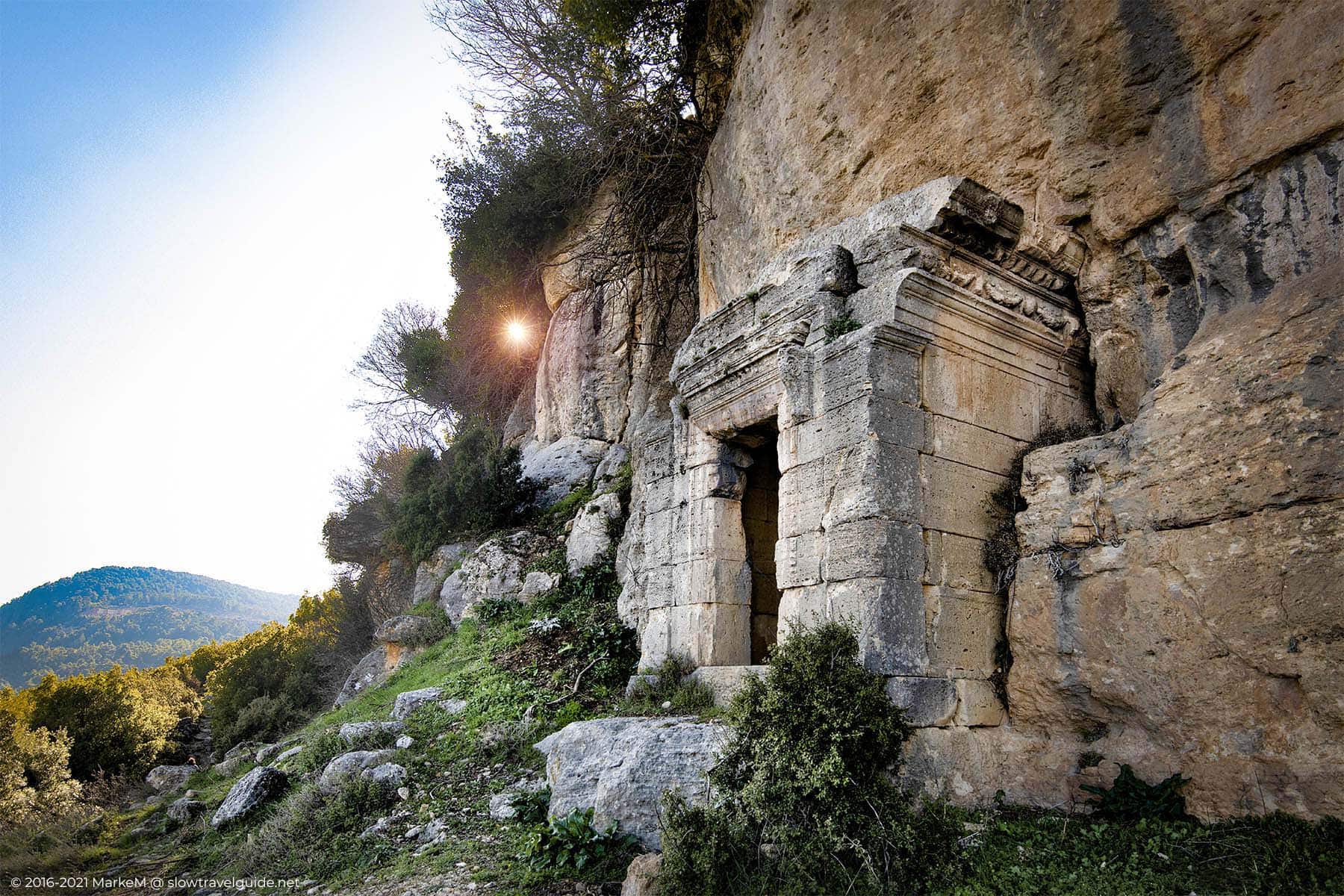
Kremna
Sometimes explaining an ancient site’s name is not easy, but Kremna’s case is straightforward. A visit to the site will make clear why Kremna is the ancient Greek for Cliff. (Read more)
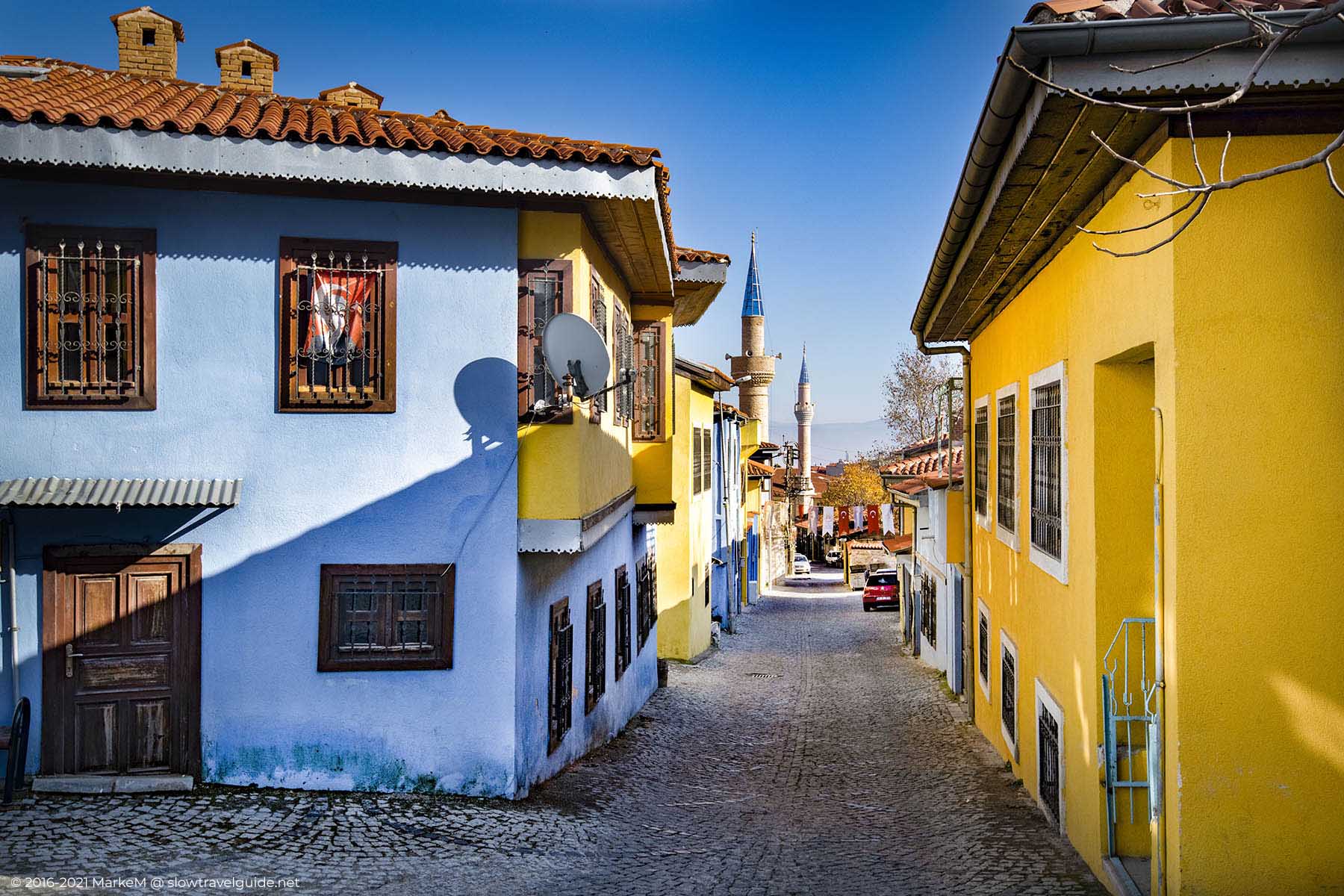
Buldan
Although not widely known by people, Buldan in the Denizli province, not so far from Pamukkale, is a town with a lovely old authentic centre. The old town and Buldan have been famous for their handwoven fabrics since before the Ottoman times. (Read more)
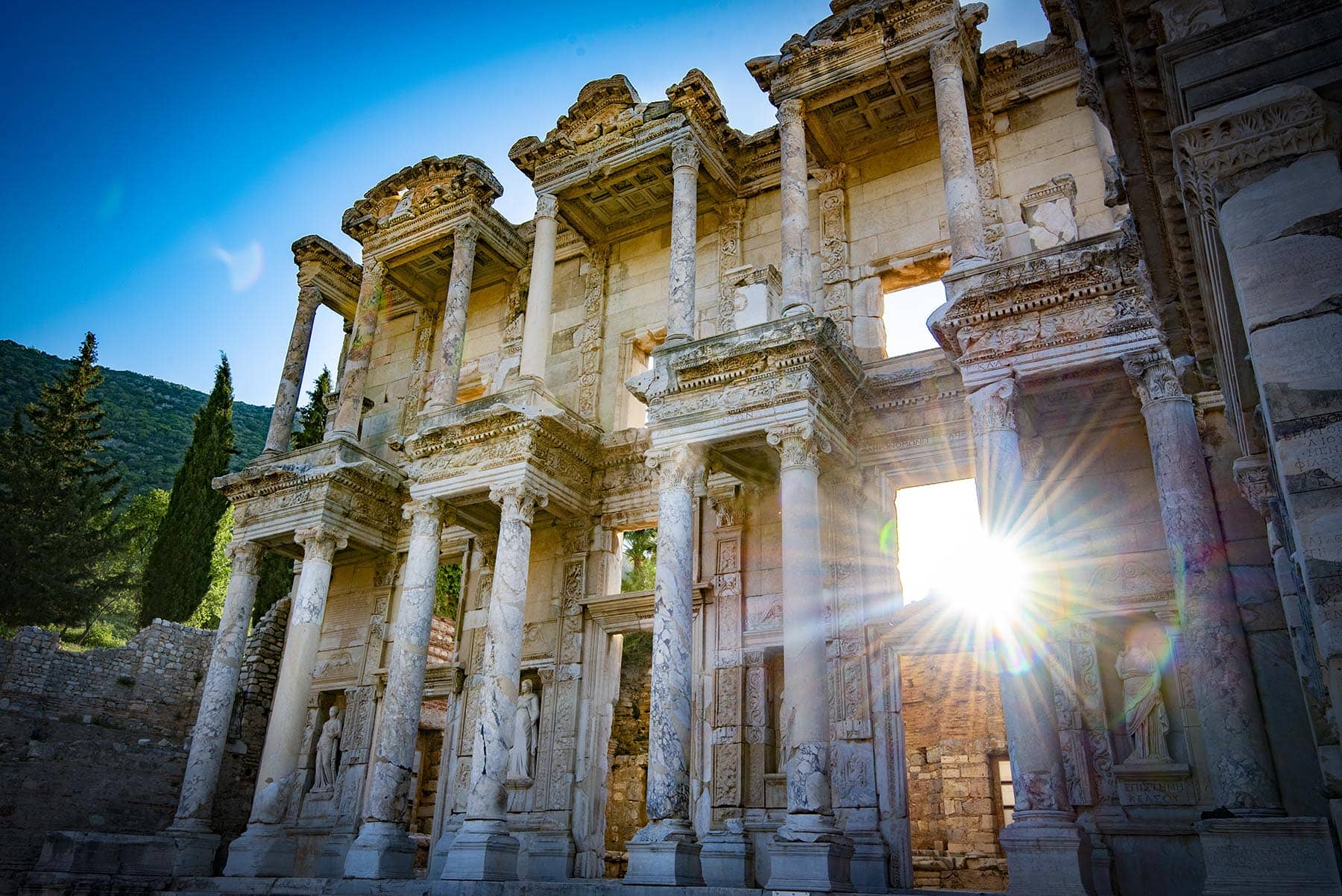
Ephesus
Ephesus (or Efes) is part of the famous Turkey Triangle Tour which also takes you to other cultural attractions, such as Istanbul, Cappadocia and Pamukkale. It was once the capital of Roman Asia Minor, and its current status is as the most comprehensive classical metropolis in Turkey and Europe. (Coming soon)
© 2016-2022 All rights reserved by slowtravelguide.net.
The content of this website is copyright protected and the property of slowtravelguide.net.No part of this website may be reproduced in whole or in part in any manner without the written permission of the copyright owner.
Copyright ©2016-2022 Tüm hakları saklıdır. Bu (slowtravelguide.net.) web sitesinin içeriği koruma altındadır ve slowtravelguide.net.Buradaki hiçbir içerik (yazı,fotoğraf,video vb.) izinsiz olarak kopyalanamaz, alıntı yapılamaz,başka yerde yayınlanamaz.

